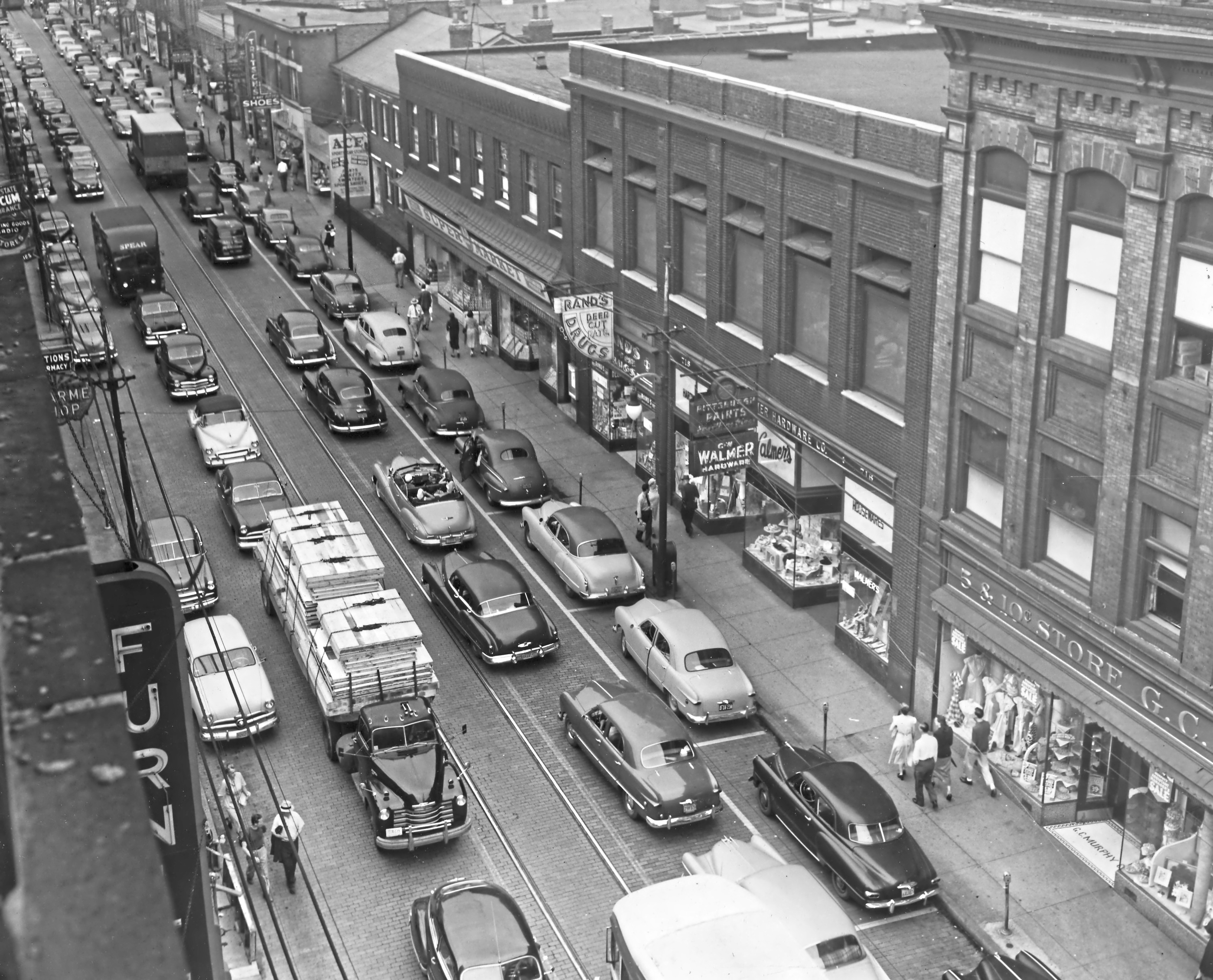









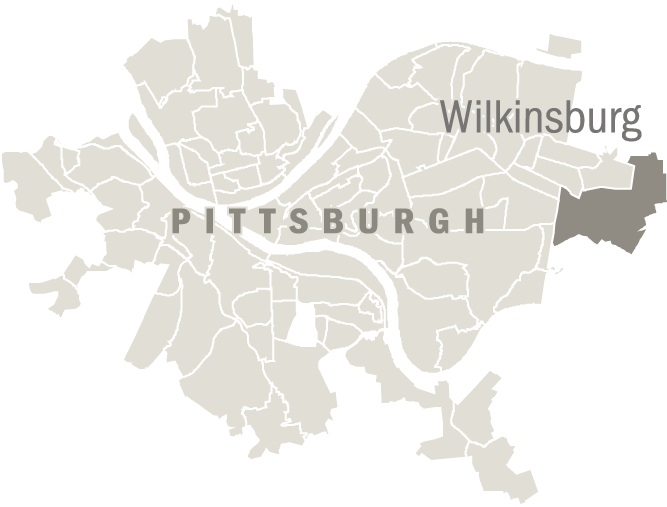
Pittsburgh annexed what is now Wilkinsburg in 1873. Furious, the community’s most prominent citizen, James Kelly, led a legal charge to reverse the takeover. The case went all the way to the state Supreme Court.
By 1876, the village was independent again.
Ever since, that response has seemed to characterize the community’s stance about merging with its bigger neighbor. When the Wilkinsburg Community Development Corp. pushed for annexation by Pittsburgh last December — petitioning the Allegheny County Common Pleas Court to approve the process — many of the borough’s residents balked.
The development group’s arguments about lowering property taxes and gaining access to cheaper city services were met with counter arguments about more bureaucracy and less autonomy. Pittsburgh City Council — court-ordered to vote on annexation — ended up voting down the move, at least for now.
“Wilkinsburg is perfectly capable of governing ourselves,” said borough Council President Denise Edwards, a former millwright at U.S. Steel’s Edgar Thomson Works in Braddock.
Her remarks echoed those made by the borough’s mayor in 1988, who swatted away a suggestion of merging with Pittsburgh: “The people of Wilkinsburg want to remain a separate community. And I think they’re fully capable of doing so,” Richard Depperman said, according to the Post-Gazette on Nov. 16, 1988.
Going back still further, Wilkinsburg voted down annexation to Pittsburgh in 1908 by a 4-to-1 ratio, with every ward against it. After the vote, the Wilkinsburg Citizens band paraded through the borough streets playing “A Hot Time in the Old Town” and “Hail, Hail the Gang’s All Here.”
That stubborn independence has survived even as the borough has navigated the choppiest of historical waters.
A middle-class enclave of about 31,000 in 1950, Wilkinsburg was the second-largest borough in the state after Norristown. But since the 1960s, it has contended with rising crime, public mismanagement, a shrinking tax base, climbing tax rates, falling school enrollment and blight even as the borough has worked to revive its economy, renew its landmarks, clean out its corruption and stay afloat.
Its many renters now worry that Wilkinsburg’s prime location is attracting developers set on gentrification, which would push them out.
A drive down the borough’s several commercial streets, with their mix of late 19th- and early 20th-century architectural flourishes, gives a hint of its former size and affluence. The 1939 Wilkinsburg directory listed some 1,400 local businesses. Many residents worked for Westinghouse Electric Corp. in nearby Churchill. The borough even threw a “Salute to Industry” in Westinghouse’s honor in 1957.
“When you were born in Wilkinsburg, you expected to live in Wilkinsburg, go to school in Wilkinsburg, marry here, find a job here or nearby places like Westinghouse or (Union) Switch & Signal (in nearby Swissvale), and die here,” one unnamed businessman said in “Historic Wilkinsburg, 1887-1987.”
The past few decades have brought crushing challenges, but this community still has assets, not the least of which is its location. With two stops on the Martin Luther King Jr. East Busway, a ramp onto the I-376 Parkway East and situated on the major artery of Penn Avenue, it’s convenient for people commuting to jobs in the city or in need of something from the Monroeville Mall.
The borough maintains a police force of 24 officers, according to the 2022 draft budget, and has six parks, a library and two public schools. It has contracted with Pittsburgh for trash collection since 2006 and fire protection since 2011 and still has a local fire station.
How Wilkinsburg got from its prosperous past to its more tenuous present requires a look into its history, especially since 1960.

The borough started modestly when land speculator Andrew Levi Levy [cq] Sr. bought 266 thickly forested acres in 1769 and named it “Africa.” At that time, custom dictated that such land parcels be given names, although no one seems to know why Levy chose this one.
In 1789, colonial army Col. Dunning McNair (or MacNair) bought the land for 322 pounds, 10 shillings, according to “Images of America: Wilkinsburg,” a 2007 book by the Wilkinsburg Historical Society. After going through several names, McNair eventually called his village “Wilkinsburg,” either after his friend and fellow soldier John Wilkins Jr. or possibly John’s son William Wilkins, a judge, U.S. senator and secretary of war.
McNair lived in Dumpling Hall, at Hay Street and Kelly Avenue, so called because its cobblestone exterior resembled apple dumplings.
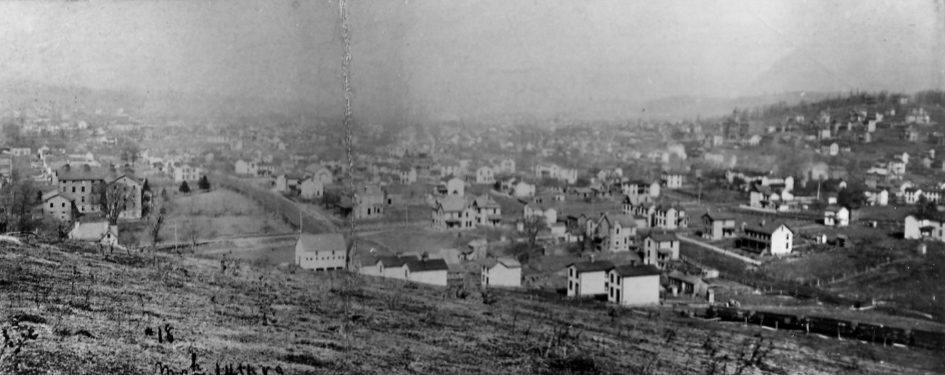
Over “great opposition,” according to the historical society book, and after two failed petitions, Wilkinsburg incorporated as a borough in 1887.
With the growth of the steel industry and George Westinghouse’s establishment of Union Switch & Signal in 1881, then Westinghouse Electric in 1888, the borough’s population boomed — from 4,662 in 1880 to its high of 31,418 in 1950.
Residents liked living in a lively borough that wasn’t too close to their industrial employers and where the sale of alcoholic beverages was illegal. Voters did not overturn the ban on liquor licenses until 2015.
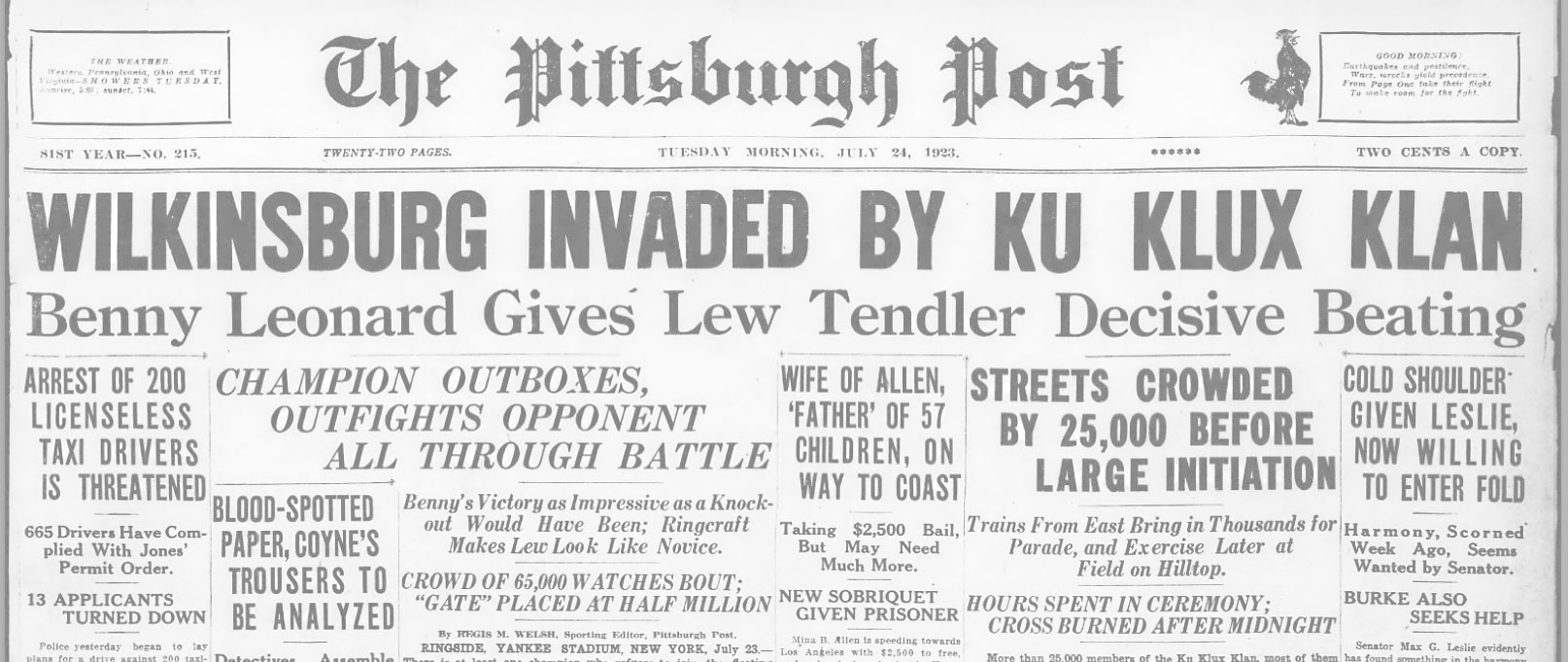
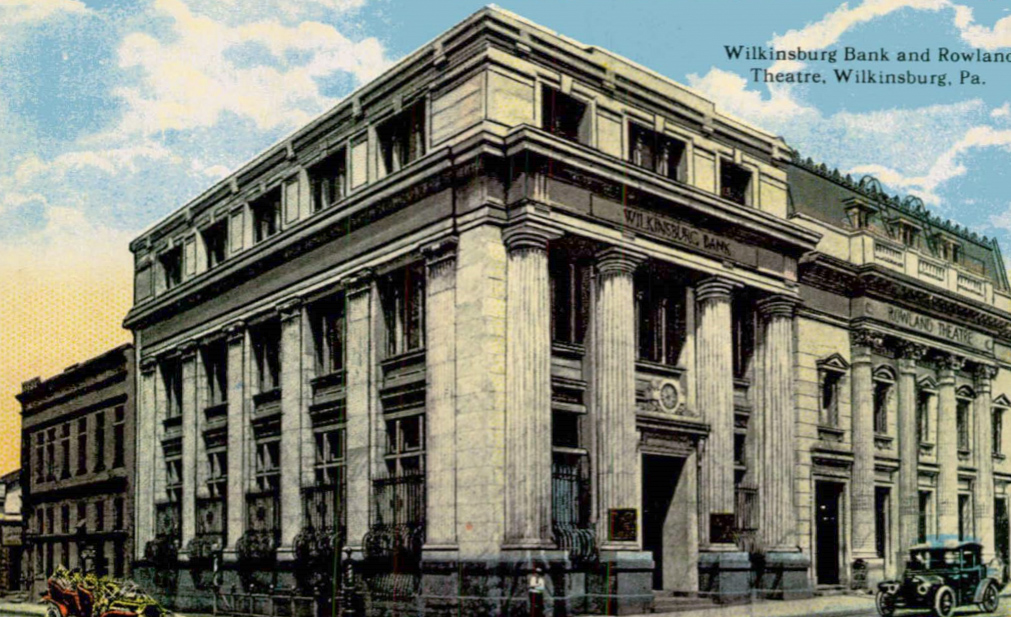
Wilkinsburg’s few Black residents, like the first Black prosecuting attorney with the county district attorney’s office, Oliver L. Johnson, may have chosen to live there because of the borough’s peace, safety and lack of bars, but they “had to confront the objections of the local Ku Klux Klan,” according to “Historic Wilkinsburg, 1887-1987.”
On May 12, 1922, four robed and hooded Klansmen drove up to Wilkinsburg High School, entered the building during school prayers, and gave an American flag to the principal. The next day, nine robed Klansmen marched down Wood Street and Penn Avenue in Wilkinsburg handing out an American flag at two fire stations.
A month later, the group held a membership campaign at the Rowland Theater on Wood Street. And, on the night of Monday, July 23, 1923, some 25,000 Klansmen — by the Pittsburgh Daily Post’s count — most of them masked and hooded, paraded through the borough before initiating about 5,000 new members and setting alight a 50-foot cross “on the hill above the Lincoln highway [sic] in Penn Avenue,” according to a July 24, 1923, front-page article in the Pittsburgh Post.

Black people could not have missed the message about the lack of welcome from many of their neighbors.
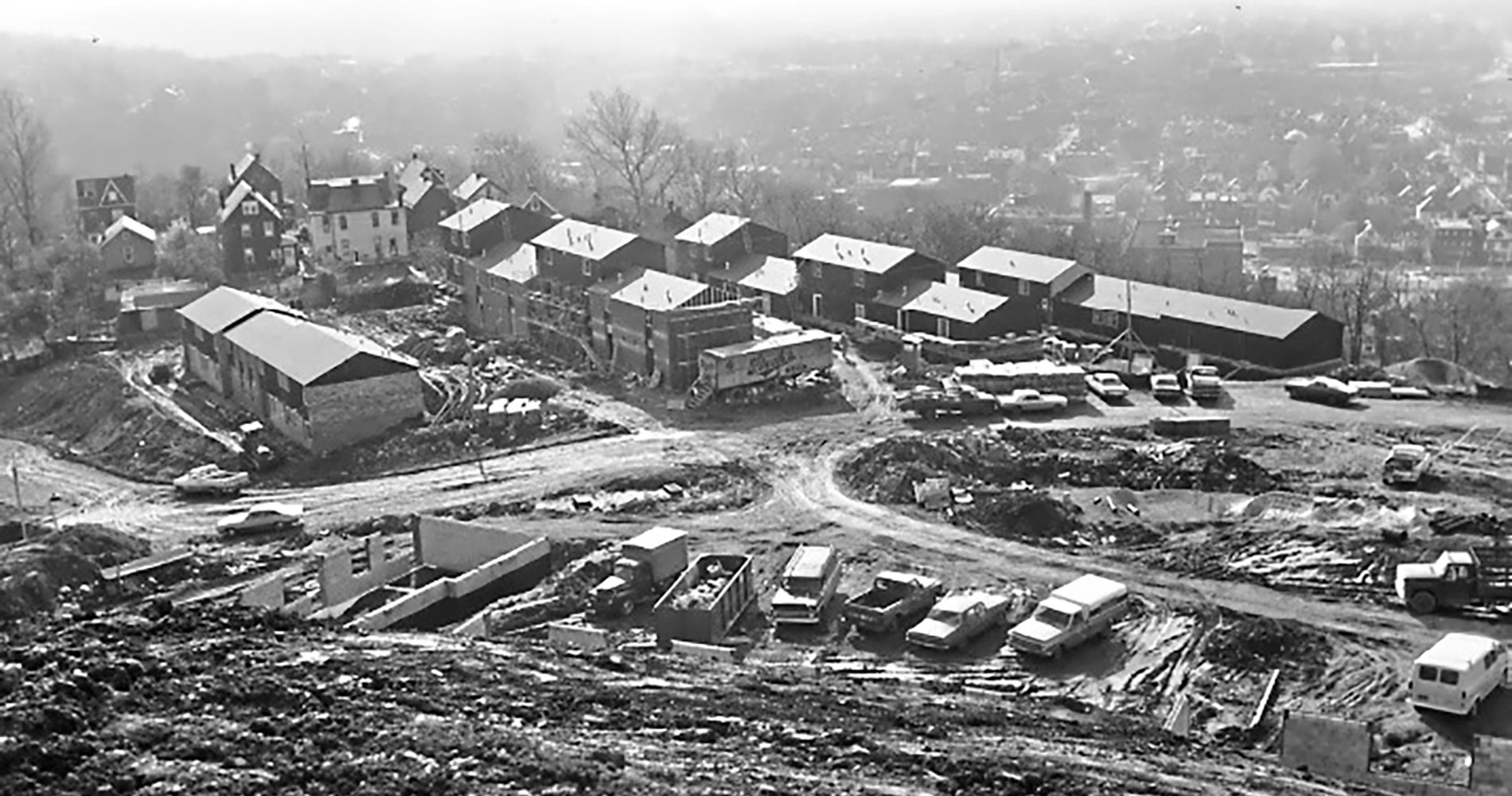
So-called “urban renewal” projects of the 1950s and 1960s aimed to direct the country’s post-war prosperity at revitalizing urban areas and eliminating blight. In Pittsburgh, that meant building a new arena in the Lower Hill District and redirecting traffic in East Liberty’s shopping district.
These two projects destroyed neighborhoods and displaced thousands of people, many of them Black and extremely poor. Some of the displaced people moved into the Homewood North public housing development and other parts of Homewood near Wilkinsburg. Others relocated not far from Homewood near Wilkinsburg’s Semple elementary school on Laketon Road.
They may have been prevented from moving elsewhere in the borough. According to a 1968 “Investigatory Hearing Report” from the Pennsylvania Human Relations Commission, incoming Black residents were “channeled into one circumscribed area within the borough.”
“The school age population at Semple therefore became predominately [sic] African American,” Marilyn Fredericka Barnett wrote in her 1990 doctoral thesis with the University of Pittsburgh, “Superintendents, desegregation and the politics of compliance: Wilkinsburg, Pennsylvania; 1968-1986.”
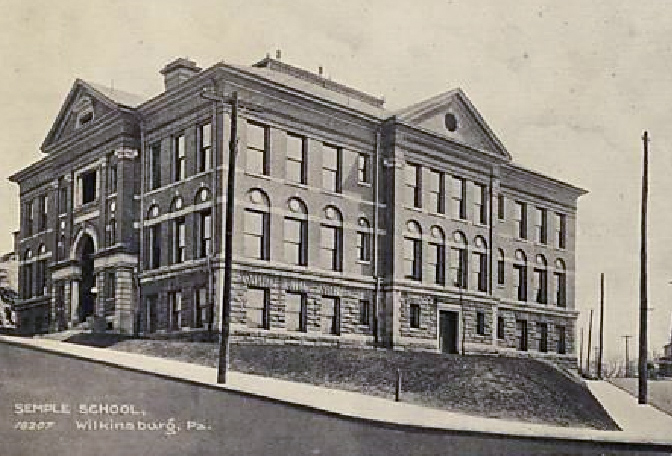
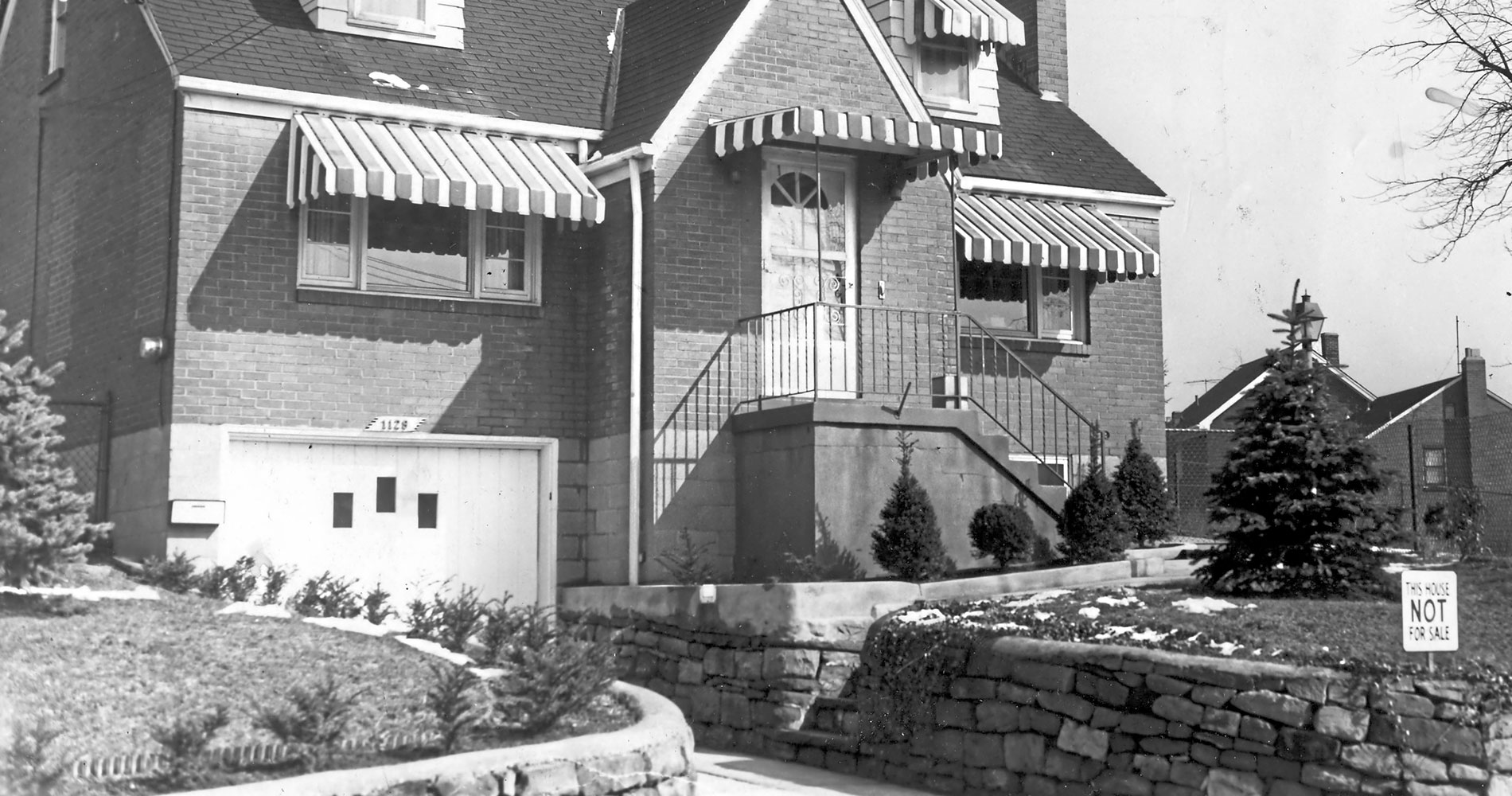
After Pennsylvania passed a fair housing law to prevent discrimination in renting or selling homes, blockbusting began in Wilkinsburg.
Even before the law was slated to go into effect on Sept. 1, 1961, real estate agents relentlessly telephoned white residents on Sherman and Pearl streets in Wilkinsburg near the Semple elementary school. The agents urged white homeowners to sell quickly and cheaply before Black homeowners moved in and, the agents said or implied, brought down property values.
These agents would buy the properties at low cost and then sell them at higher prices to incoming Black families.
“For Sale” signs began popping up along Sherman and Pearl streets, and at least 10 properties on them sold between 1961 and 1966.
Not everyone bought into the fear of the change that might be coming. A March 4, 1961, Post-Gazette story reported that two homeowners defiantly posted their own signs.
Their message: “This House Not For Sale.”
On Feb 2, 1968, the state of Pennsylvania sent Wilkinsburg and 16 other school districts a letter. The requirement: that they work to achieve racial balance in their schools.
From 1968 to 1986, four Wilkinsburg school superintendents gave this directive a tepid response at best, resistance at worst. The first superintendent to grapple with the issue, William Potter, missed four deadlines to submit a plan.
When a plan was finally adopted, it called for the district’s Semple elementary school — where the student majority had shifted over a decade or so to Black children — to be closed. The rationale was that it was “architecturally unsound for educational purposes,” reported The Pittsburgh Press on Nov. 19, 1974.
In the mid-1970s, Semple students were transferred to Turner elementary, according to a May 1980 Post-Gazette report. By 1980-81, Allison Elementary had mostly Black enrollment, while Johnston and Kelly elementary schools were overwhelmingly white. The Turner elementary school had a more balanced demographic, with 239 white students to 150 Black students.
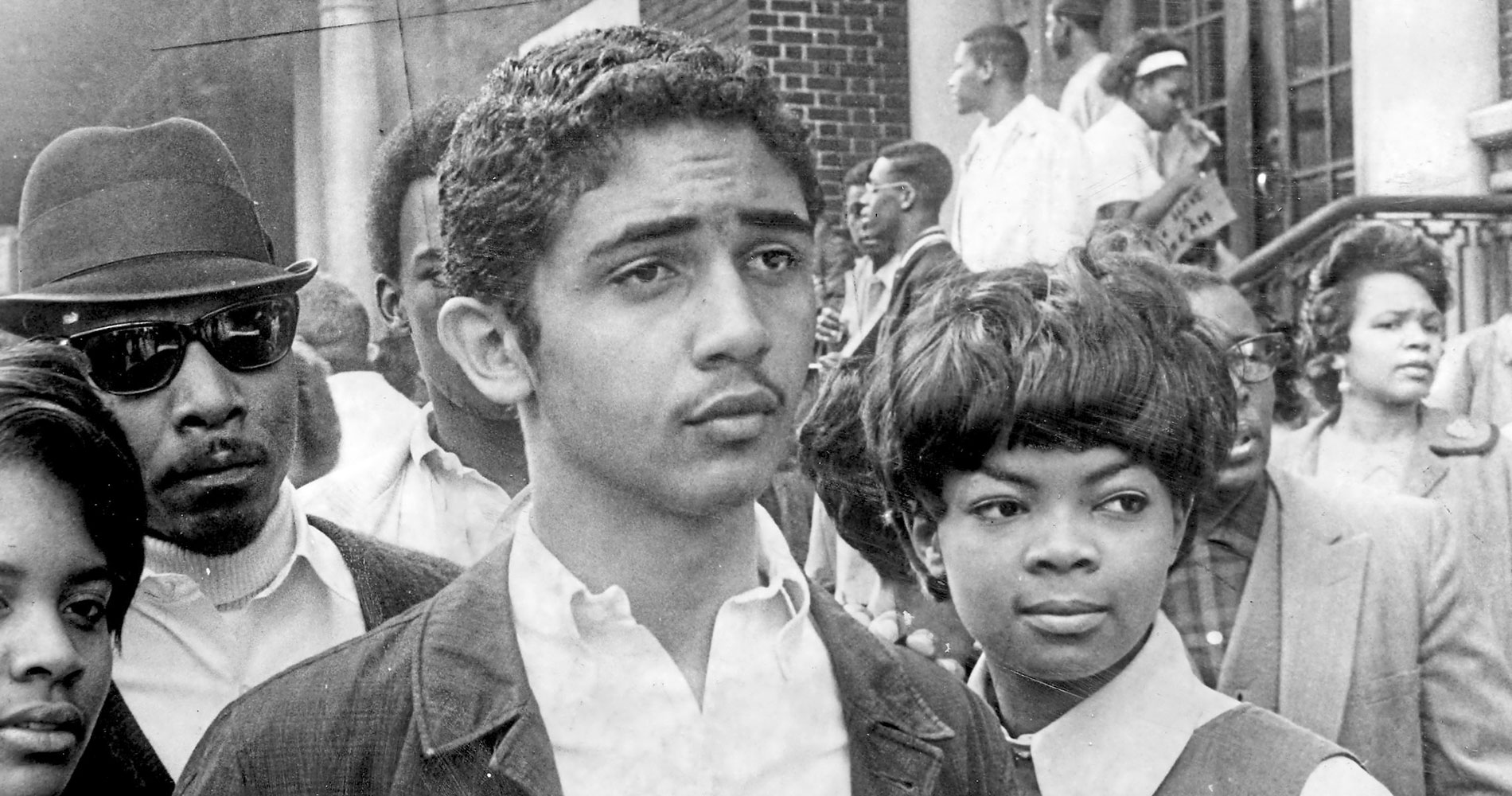
The borough’s changing demographics were a factor in more than one newspaper story about conflict inside its schools, especially in the 1960s and 1970s, a time when the nation was grappling with changes called for through the American Civil Rights Movement and overall unrest tied to disagreements over the Vietnam War and the country’s political leadership.
By 1968, about 80 of the 318 students in the Wilkinsburg High School graduating class — roughly 25% — were Black. That May, the Pittsburgh Courier reported a Black student who ran for class president had been “disqualified” from running and had received threatening letters from an anti-Black group.

Another Black student who was assistant drum major and by tradition should have become head drum major in his senior year was also disqualified from the position.
Still another was denied the “father” role in a school play because a white girl had already been cast in the “mother” role. He was offered the role of janitor or butler instead.
When a spokesman for Black parents and students mentioned at a school board meeting that there should be some Black members of the board, several white people at the meeting yelled, “Well, you’re never going to get it!” according to the Courier.
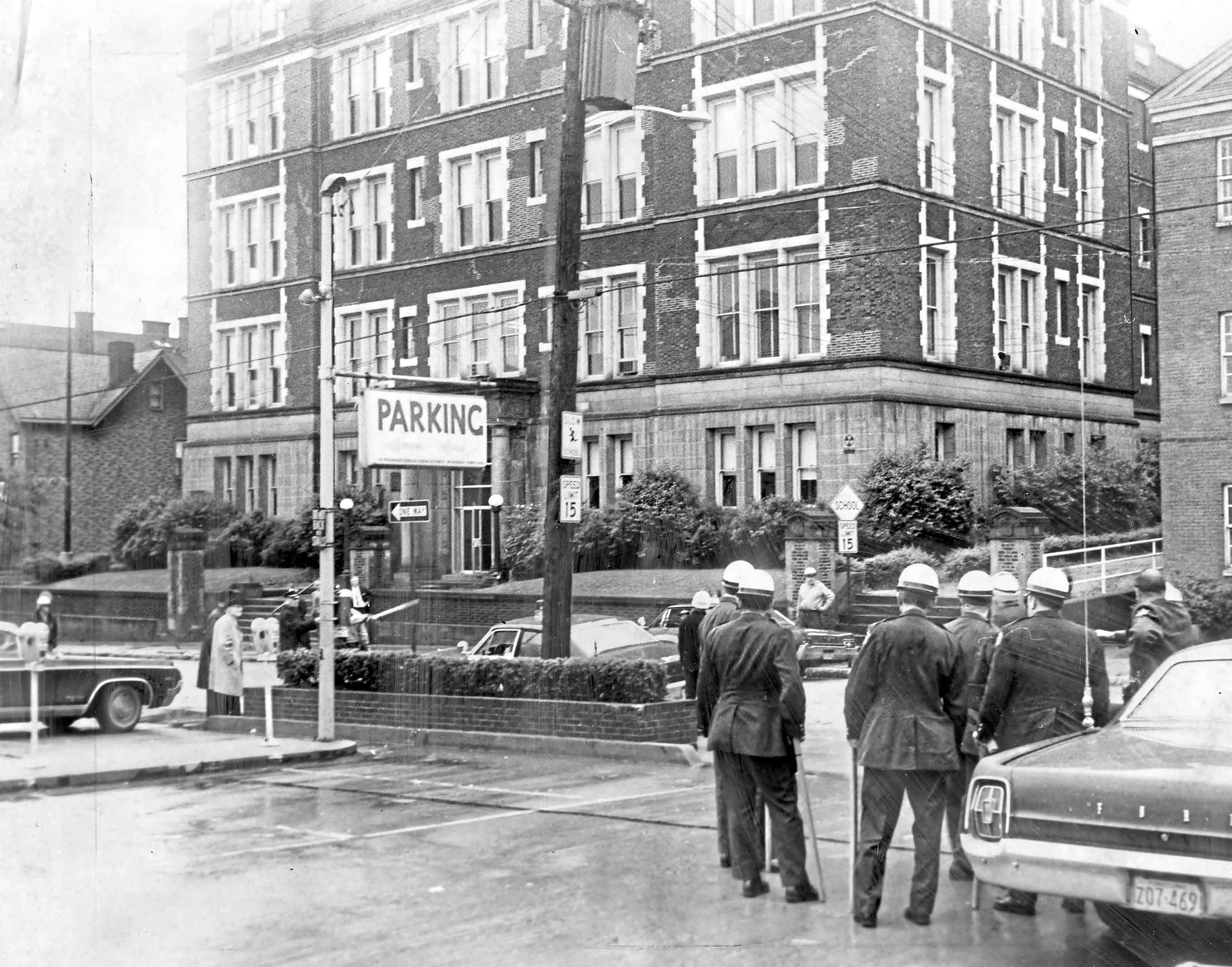
The assassination of civil rights leader Martin Luther King Jr. on April 4, 1968, touched off nationwide rioting.
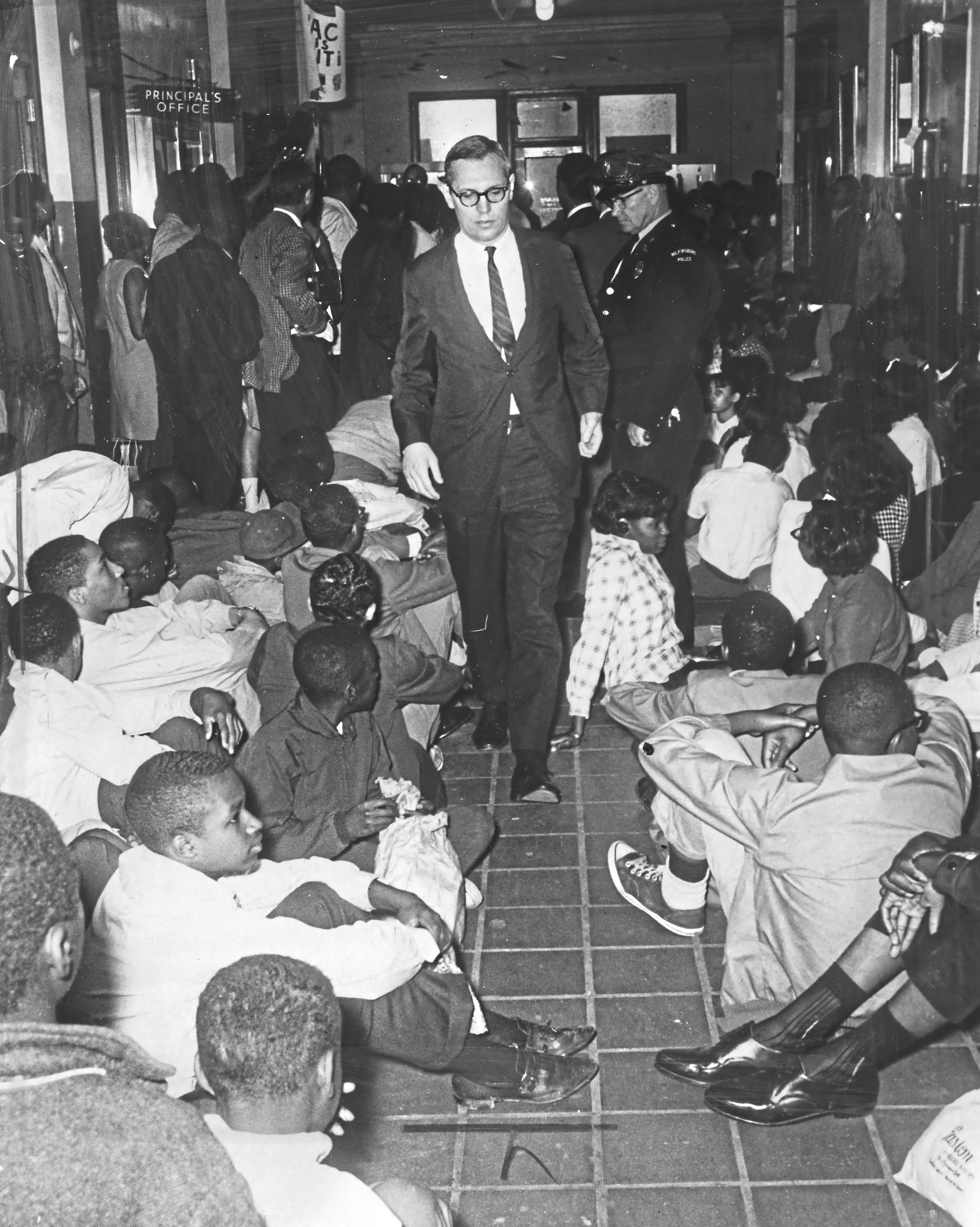
Black students in the Pittsburgh region stayed home from school “by the thousands” on April 8, the day before King’s funeral, according to an article in The Pittsburgh Press. Wilkinsburg schools closed the day of the funeral. And, after rioting took place April 5 to 11 in Pittsburgh, many municipalities in the area, including Wilkinsburg, imposed curfews on teens and children.
At Wilkinsburg High, 275 Black children and about 20 of their parents held a “sit-in” demonstration on May 21 in the hallway in front of Superintendent Potter’s office, according to The Pittsburgh Press. The organizer — a student — produced two letters from a white “Anti-Negro Association.” One letter said in part, “We don’t want any [racial insult] in any class office in this school.”
School administrators called in the police, who brought some 25 sheriff’s deputies and a dozen police from Penn Hills. Administrators closed the school for the day.
Two nights later, according to the Post-Gazette, borough police repelled a “gang” of about 100 young people armed with baseball bats and bicycle chains trying to enter the borough. News accounts did not specify the race and origin of the group. Wilkinsburg’s mayor charged “professional outside agitators have linked up with local Black militants to harass Wilkinsburg,” the PG reported.
Fights broke out the next day between Black and white students, both girls and boys. Police and firefighters began patrolling the halls of Wilkinsburg High.
While other high schools in the area did not immediately have similar problems, they would in the months that followed — with school closings, demonstrations and fights taking place in schools in Pittsburgh, Braddock, Aliquippa and across the nation.
By April 1971, The Press was reporting some Wilkinsburg parents had begun paying tuition to send their children to the Edgewood school district.
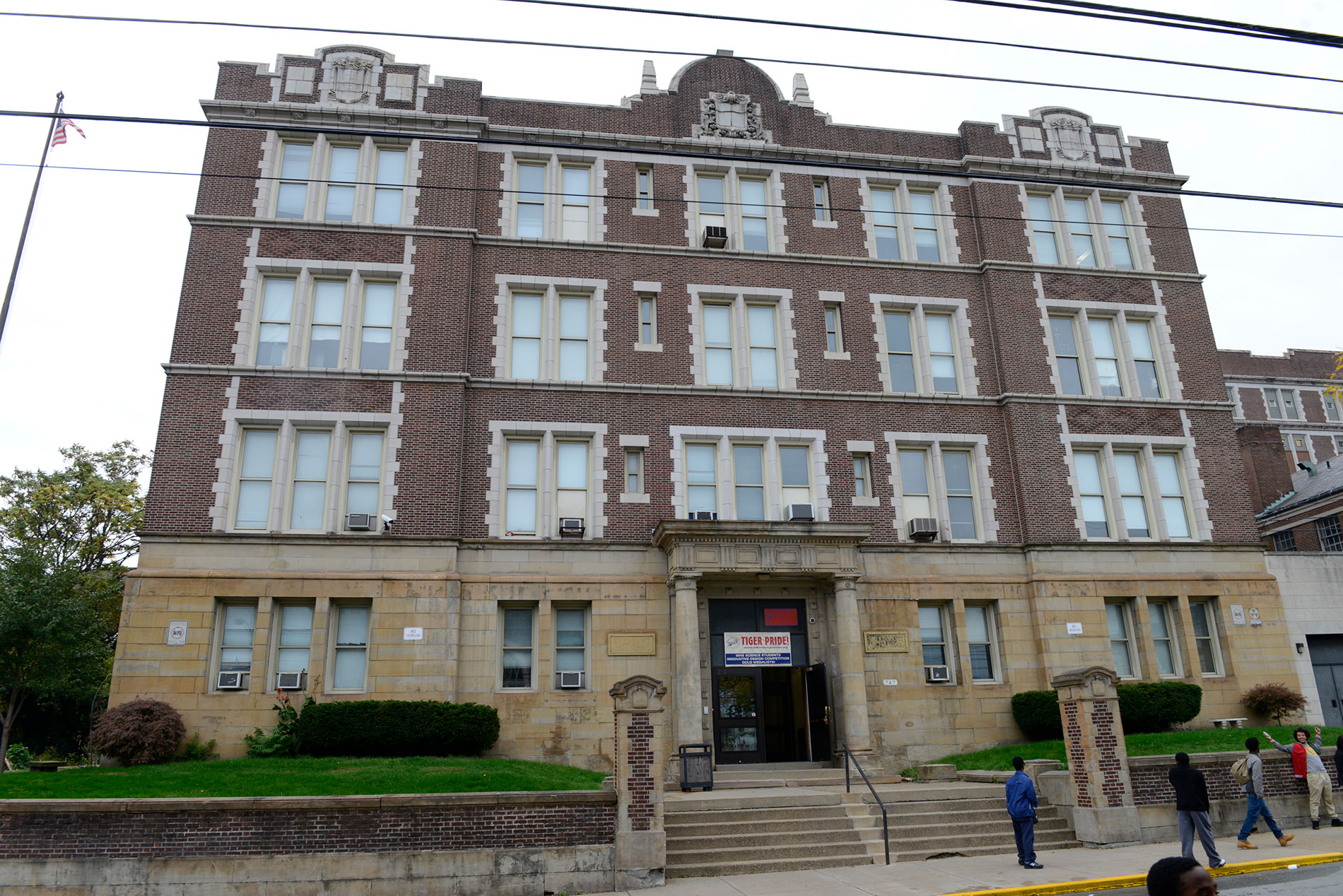
Meanwhile, across Pennsylvania, many smaller districts were dealing with strains on their educational resources and finances.
In 1961 and 1963, the state legislature passed laws requiring school districts to merge. Wilkinsburg successfully argued it exceeded the state’s minimum enrollment of 4,000 pupils (it had more than 4,508, according to the Wilkinsburg Gazette on Jan. 17, 1963) and therefore should not be included in the plans.
Mandated school mergers arose again a decade later. In 1973, the state Board of Education ordered a realignment to desegregate the predominantly Black school district known as General Braddock Area — itself a 1968 combination of the former Braddock, North Braddock and Rankin districts.
Wilkinsburg’s school Superintendent Charles W. Krepps Jr. proposed two new districts be formed with Wilkinsburg schools merging with those of Swissvale, Rankin, Edgewood and Churchill. State officials accepted the plan, a move that “flabbergasted” even Krepps, according to an article in The Pittsburgh Press. State officials then presented the plan to the federal judge presiding over the desegregation case.
Some residents strongly opposed the proposal and demanded Krepps’ ouster, according to a Jan. 15, 1974, article in The Press. At the school board meeting that night, Krepps “stunned” the school board and about 300 residents by announcing his resignation.
The federal judge rejected the plan in May 1975, suggesting state officials hadn’t addressed local objections to busing and other issues. From June 1975 onward, Wilkinsburg was never included in any school district merger plans.
When Woodland Hills School District came into being in 1981, it comprised the former General Braddock, Edgewood, Churchill, Swissvale and Turtle Creek school districts. Wilkinsburg School District stayed independent.
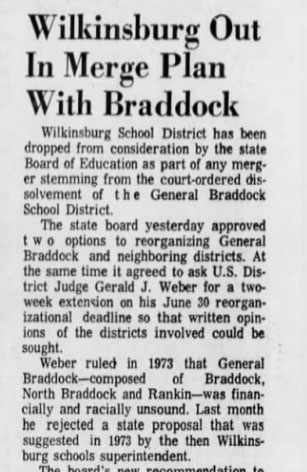
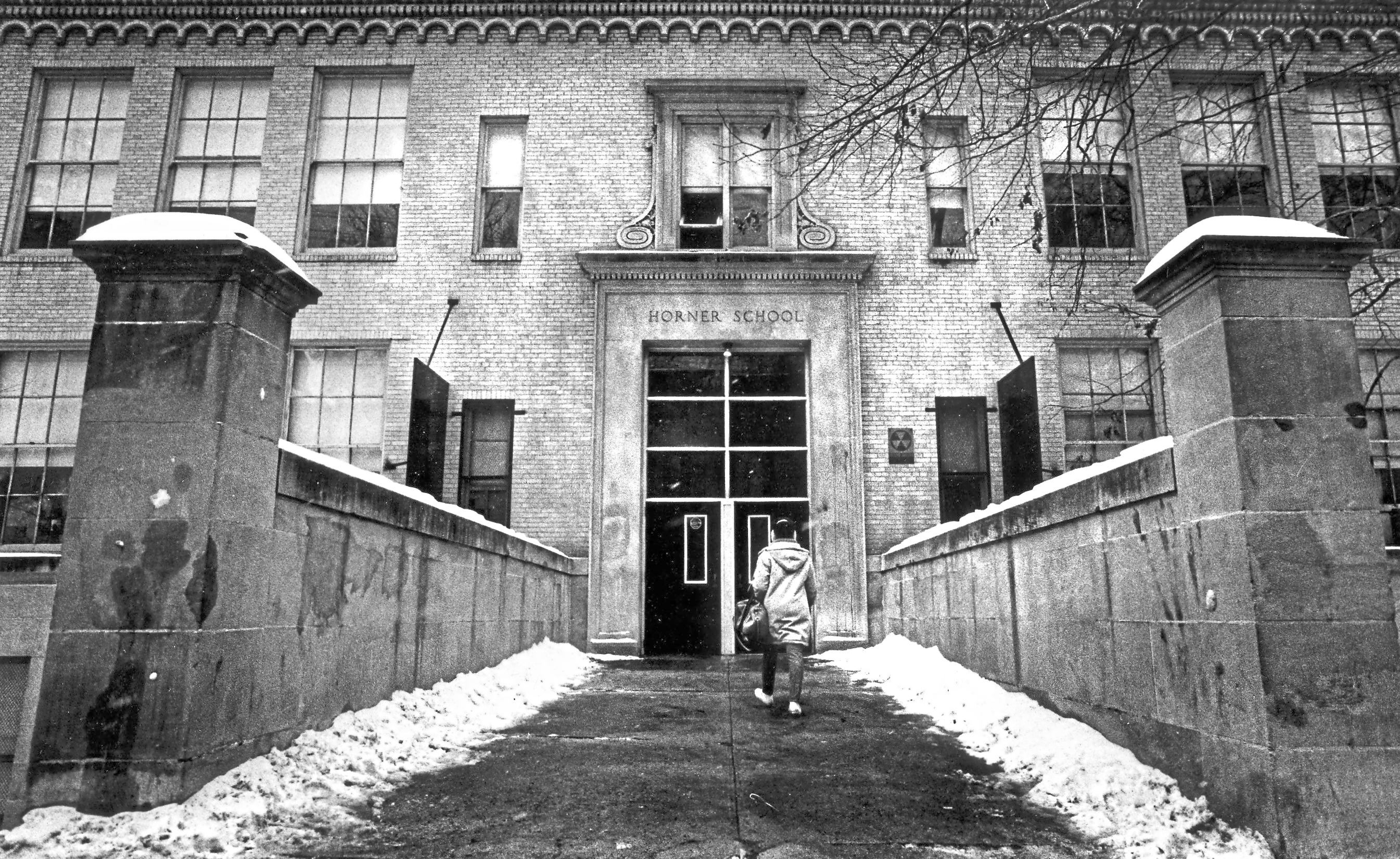
Wilkinsburg’s decision to keep its school district independent at first seemed reasonable. In 1963, Wilkinsburg High School offered French, Spanish, German, Latin, mechanical drawing, sociology, economics, theater arts, journalism, advanced music, advanced physics, advanced chemistry, a gifted program, and Advanced Placement classes in English, history, calculus and analytic geometry.
By 2015, the AP classes, the gifted program and upper level classes in every subject were gone. Math, for instance, only went up to pre-calculus, and the list of courses ran to only eight pages. Pittsburgh Public School District’s list of courses, in contrast, is an inch thick.
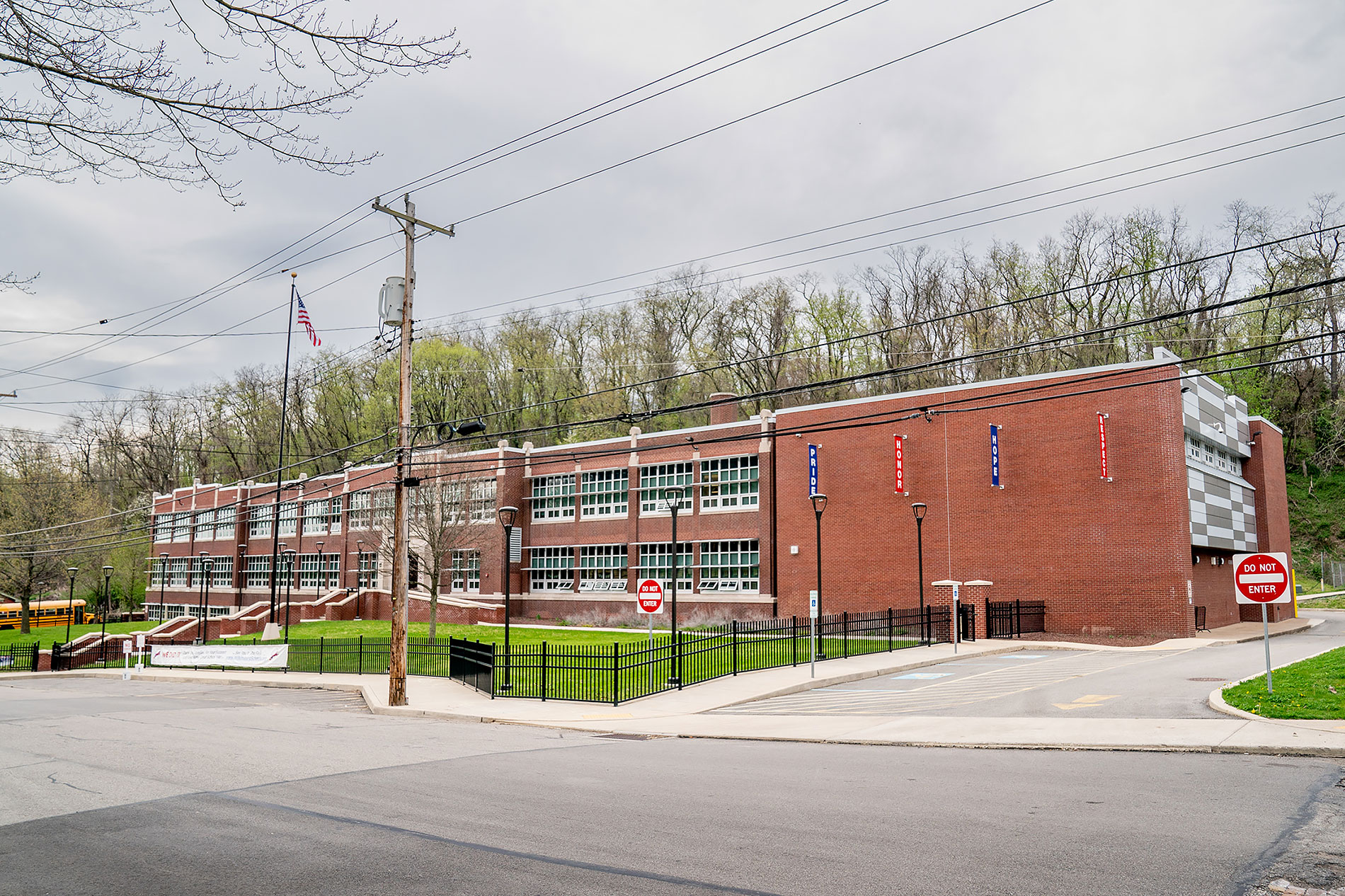
The district’s academic score for the 2012-2013 school year was the lowest of any regular public school in Allegheny County and its rate of chronic truancy was the highest. The district’s inability to fill teaching positions meant an art teacher taught high school chemistry in 2013 and a gym teacher taught French.
White flight had taken place over the decades, a major factor in falling school enrollment, which dropped from 4,647 in 1967 to 2,246 in 1986, according to Marilyn Fredericka Barnett’s thesis. In response, the district closed and consolidated schools, laid off teachers and cut courses.
As educational offerings dwindled, financial troubles grew. In the 2010-2011 school year, the Wilkinsburg district had to borrow $3 million to pay its bills.
Bowing to what many people viewed as the inevitable, Wilkinsburg’s middle and high school programs closed in 2016 and most of the roughly 220 students were sent to Pittsburgh’s Westinghouse Academy 6-12 in Homewood West. Wilkinsburg’s last graduating class had just 25 students.
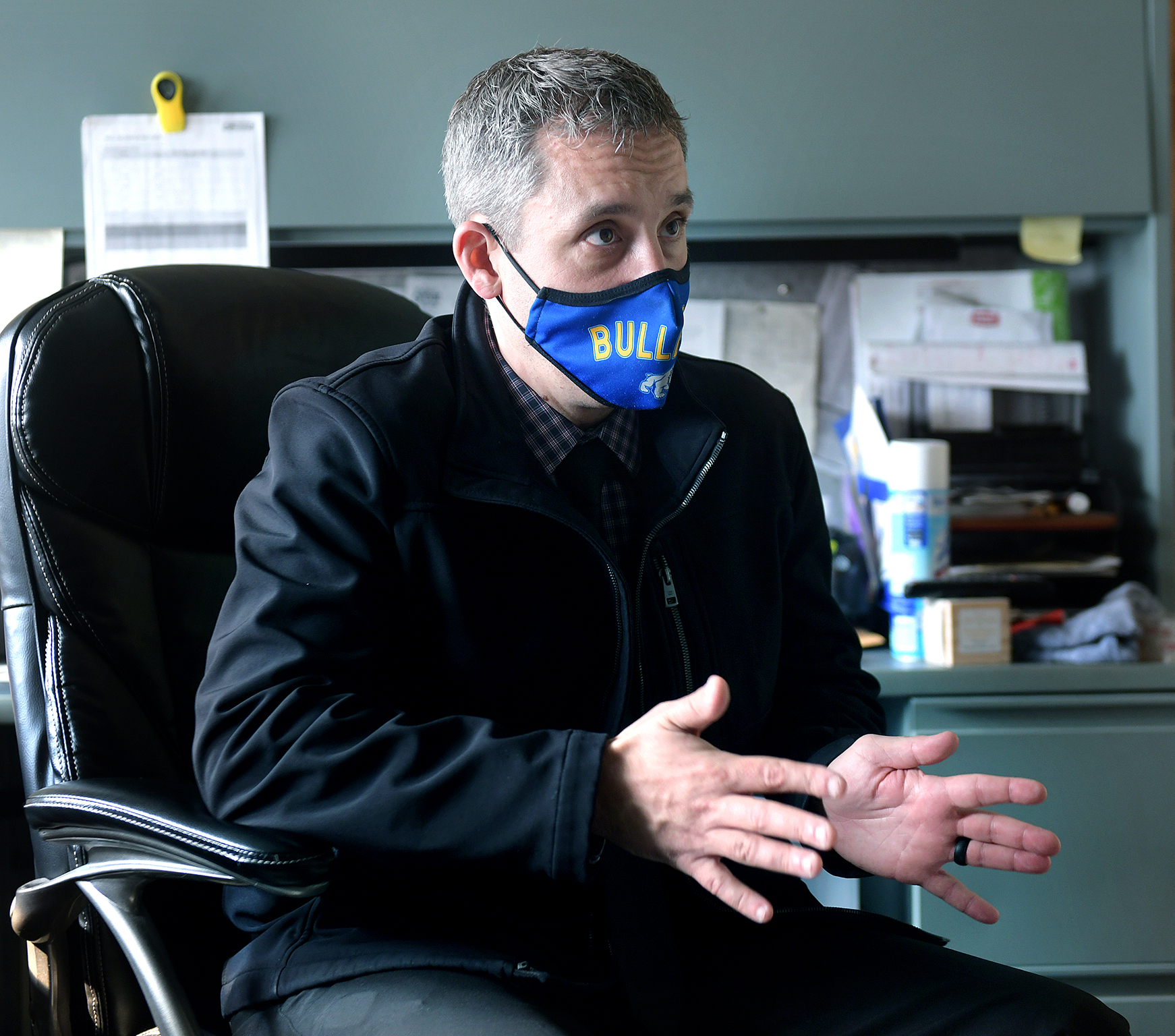
Today Wilkinsburg School District is composed of two elementary schools with total enrollment of between 500 and 525 pupils: Kelly Primary, which has pre-K, kindergarten and first grade, and Turner Intermediate, which has second to sixth grades. The district spent $14 million to renovate Turner and now offers students smaller classes, more classroom aides, more support for learning difficulties, literacy and math coaches, online tutoring and a virtual academy.
“Students love it!” Wilkinsburg school district officials said in an email.
Middle- and high-school age students Wilkinsburg students attending Pittsburgh Public are experiencing higher cumulative grade point averages, better attendance and fewer discipline cases, according to Wilkinsburg district officials.
Wilkinsburg students comprised not quite half of the incoming seventh grade this year at Westinghouse, where they can eventually take AP classes and earn up to 12 college credits through the University of Pittsburgh.
The relationship isn’t exactly a merger — the step that many had fought for years — but it is an acknowledgement the district no longer stands entirely on its own.
In 1950, there were close to 31,500 people living in Wilkinsburg. Only 502 were Black.
That tiny 1.6% slice grew to about 2% over the next two years, according to an article published in The Pittsburgh Press in the late 1980s. The borough’s faces were mostly white.
But change was coming.
By 1974, Black residents comprised 25% of the borough’s population, and many had school-age children. Black students accounted for 55% of the schools’ enrollment at that point, according to Marilyn Fredericka Barnett’s 1990 University of Pittsburgh doctoral thesis, “Superintendents, desegregation and the politics of compliance: Wilkinsburg, Pennsylvania; 1968-1986.”
The trend continued. By 1979, Wilkinsburg’s population would be tallied at about 37% Black and the borough schools were more than 73% Black.
New families with school-age children caused school enrollment to surge in the 1960s, a change that hadn’t been anticipated back in 1959 when the borough was planning for its future.
Elementary school enrollment for 1966 was projected to be 1,455 — the actual enrollment was 2,844. Similar increases were seen in the junior and senior high school, according to a mid-1960s analysis by the Pittsburgh Regional Planning Association.
Meanwhile, the poverty rate was rising — in part because some of the new residents had been displaced by urban renewal developments elsewhere that eliminated affordable housing stock.
In the 1960 census, 12.7% of the borough population was earning under the poverty line for a family of four, with another significant group just above it, according to the planning association’s study.
Wilkinsburg’s estimated poverty rate for 2021 is 26.2% compared to 19.7% for Pittsburgh. The borough’s 2020 median household income was $37,649.
It’s a far cry from the days of the early 20th century when nearby employers supplied convenient, solidly middle-class jobs for many in Wilkinsburg.

As the steel industry slowed in the 1970s and imploded in the 1980s, the Pittsburgh regional economy collapsed. Steel workers and their families left to seek other jobs in other parts of the country, setting off still more emigration among those whose work was tied to those communities.
Wilkinsburg was not spared. The borough in 1970 had a population of 26,780. It fell to 21,080 in 1990 — a 21.3% decline.
Other major local employers were also foundering, contributing to the regional economic decline. Westinghouse employed 22,000 local workers in 1985. That figure sank to 13,500 in 1994, then to 7,000 in 1997.
Union Switch & Signal issued paychecks to about 2,000 local employees in 1980. By 2005, that number was down to 550. The company closed its Swissvale plant in 1987 and moved manufacturing to South Carolina.
On Wilkinsburg’s commercial streets, the number of businesses dipped into the 400s, according to a 1987 list — a steep drop from the more than 1,000 listed in 1939.
By 2008, more than 40 of the 127 storefronts along Penn Avenue and Wood Street were listed as vacant.
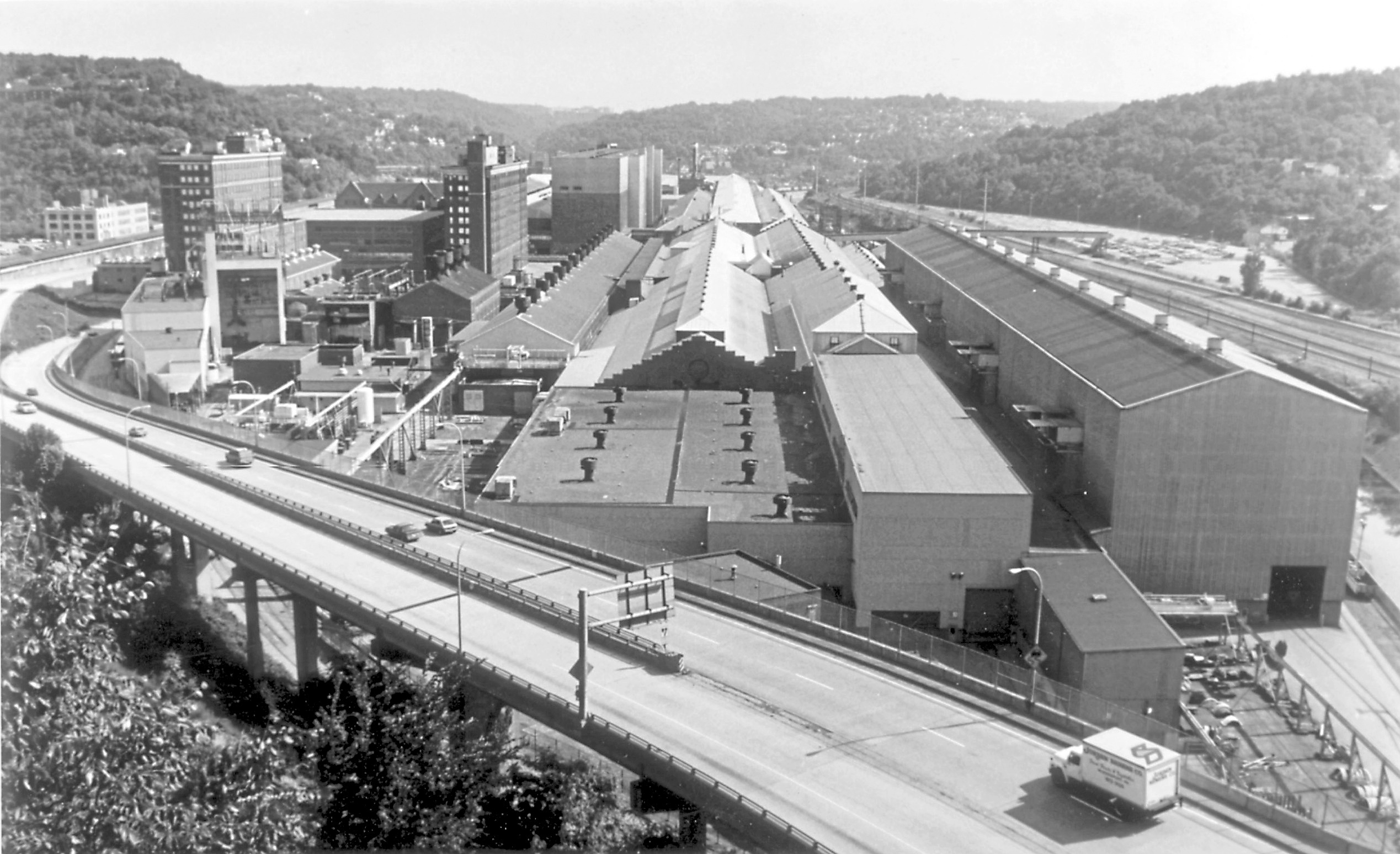
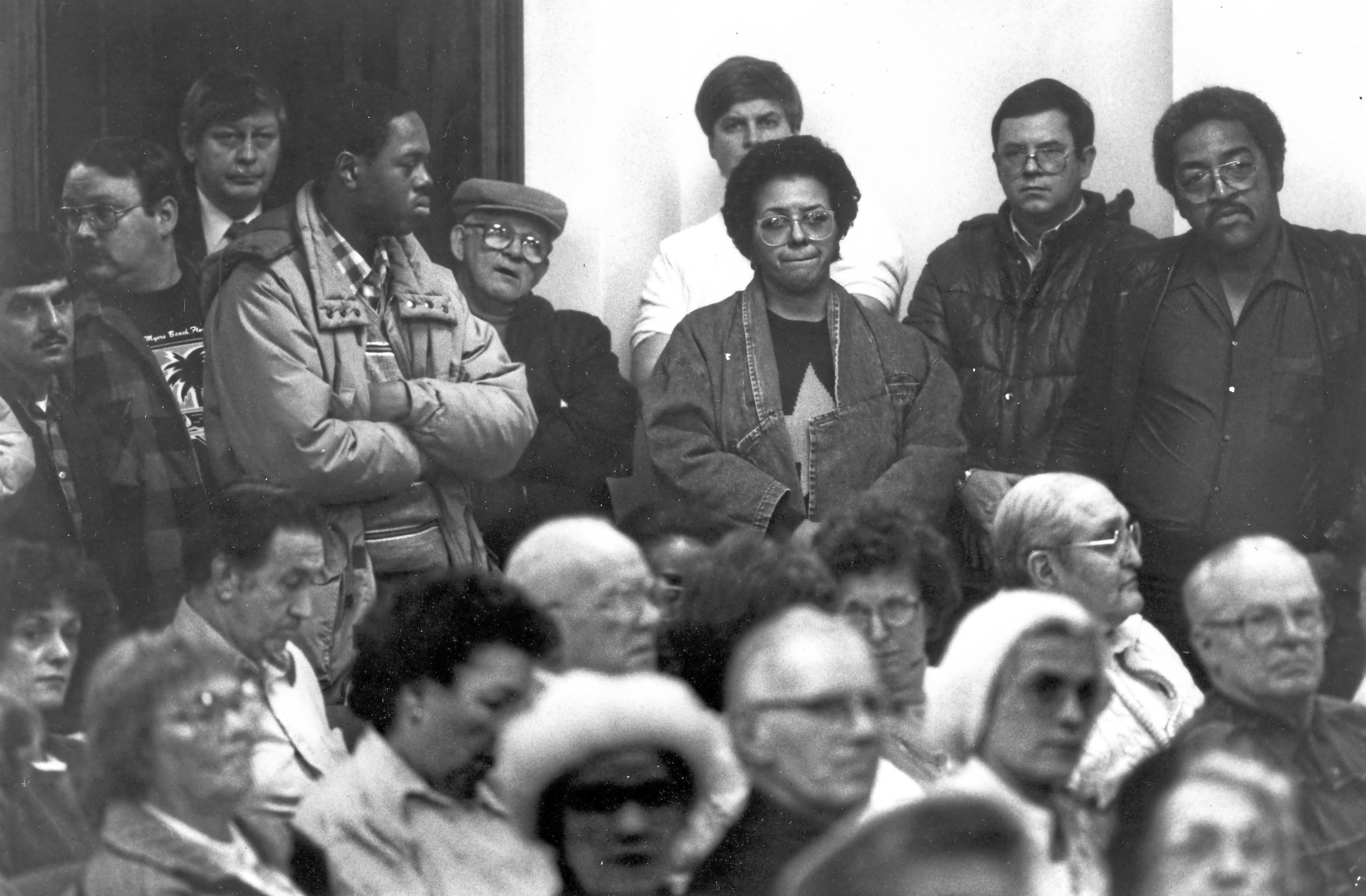
As Wilkinsburg contended with changing demographics and rising poverty, it also faced problems with its internal management.
In 1981, a newcomer won election to the borough’s council — admitted former heroin addict and ex-convict Patrick O’Leary. He promised to clean up the borough government as he had reformed himself. The next year, council members elected him president and re-elected him in 1986.
But borough government did not improve. A resident’s question in 1987 about why Wilkinsburg was running out of money to pay its employees led to the state auditor general launching a criminal investigation. The review found “shocking” evidence of missing records, financial improprieties and poor bookkeeping. Borough tax records were in boxes stacked to a leaking office ceiling, the Post-Gazette reported in March 1988.
Moreover, the borough had been lax about collecting revenue. Some people had borrowed money through a municipal loan program, sold their houses and then did not repay the debt.
“Wilkinsburg suffered from poor management and poor fiscal controls for several years until about early 1988,” said Mark Weitzman, who served on the nine-member borough council from 1986 through 1993 and was council president from 1990 to 1993.
Wilkinsburg kicked off 1988 by asking state government officials to declare it a “distressed community.” The borough was between $585,000 and $1 million in debt. Under state law, distressed communities have access to no-interest loans or state grants.
As the borough obtained loans and funding to get back on sound financial footing, many of its officials resigned or were replaced. In 1987 and 1988, Mr. O’Leary was arrested for buying heroin. He left council in 1988 and served nearly a year in the county jail on drug charges. He was sentenced to prison in 1990 for accepting bribes to award a contract to repair the borough municipal building to Forest Hills contractor Ralph Simeone, who then bilked Wilkinsburg of $23,000.
In 1997, the state removed Wilkinsburg’s distressed status. The borough went to court to retain the designation, but lost the case in 1999.

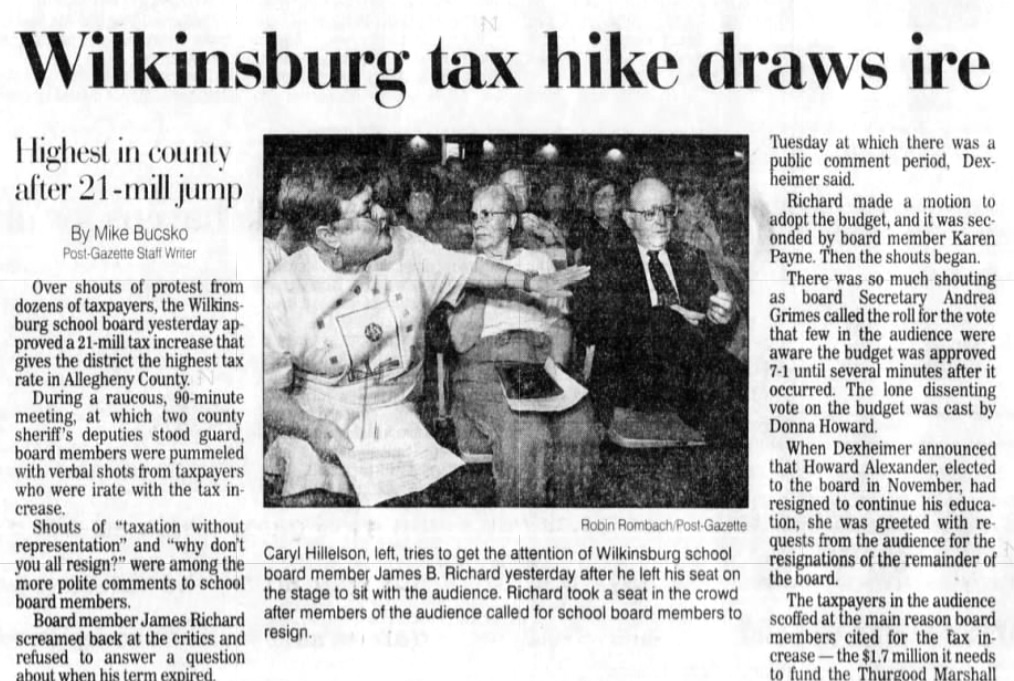
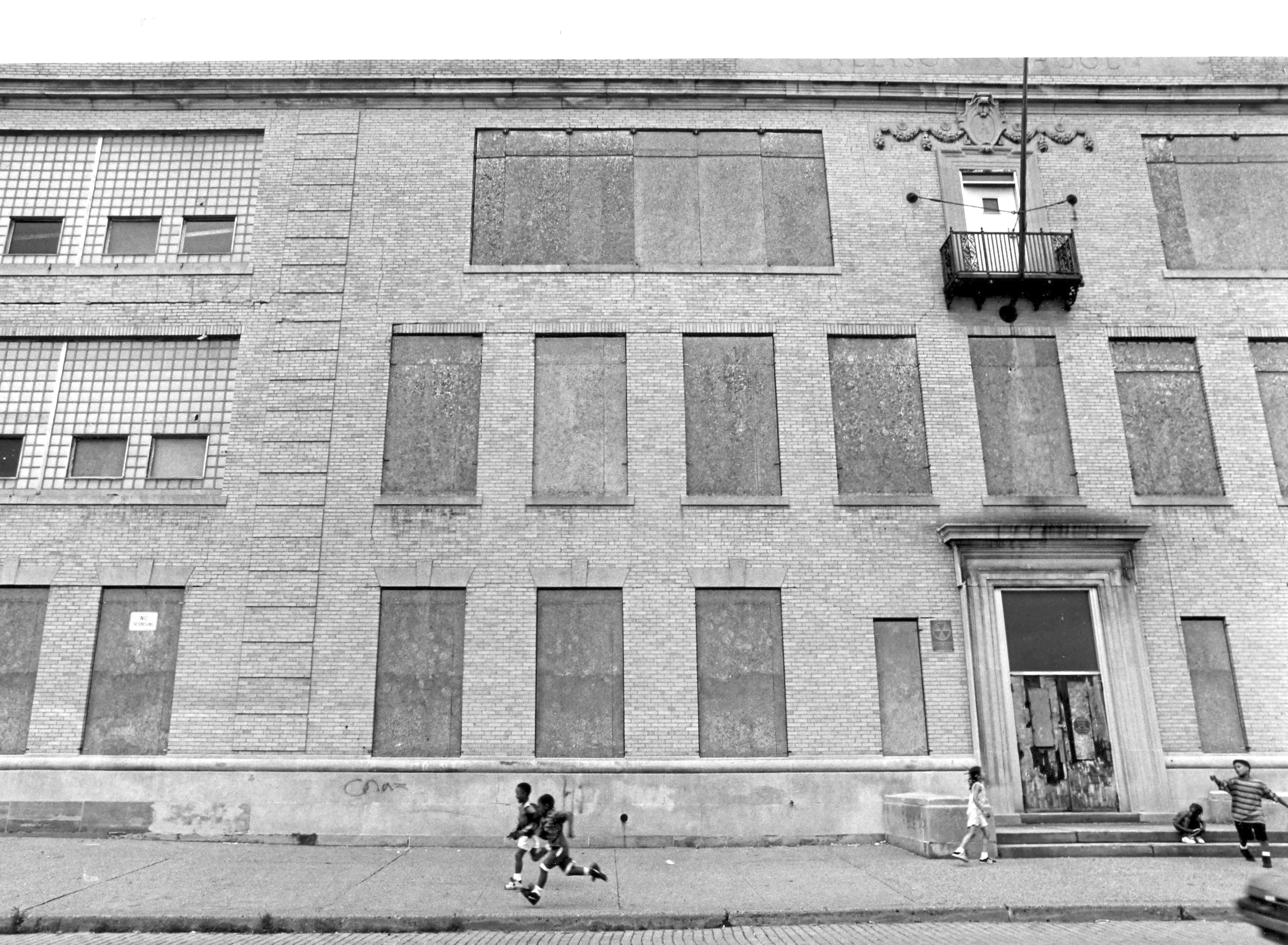
Wilkinsburg was struggling to pay its bills — and, in turn, wrestling with a rising tax rate.
In 1962, the borough property tax stood at 16.5 mills, as reported in the Wilkinsburg Gazette. That rose to 28.5 mills by 1979, then jumped to 45.7 mills in 1980.
One mill is the dollar amount taxed on every $1,000 of a property’s assessed value.
A county property reassessment partly fueled this steep rise — Wilkinsburg’s assessed property valuation had dropped between 18% and 19%. Another factor behind the tax hike was the rising cost of the schools, even as the district trimmed offerings like football and band camps.
The borough’s tax rate currently stands at 48.23 mills — made up of a 14-mill municipal property tax, a 29.5-mill school property tax and 4.73-mill county tax. A Wilkinsburg homeowner whose property was assessed at $100,000 would pay annual taxes of $4,823.
By contrast, Pittsburgh has a 10.25-mill school tax, an 8.06-mill municipal tax, a 0.50-mill park tax and a 0.25-mill library tax with the county tax the same, for a total of 23.79 mills. A Pittsburgh homeowner with a house assessed at $100,000 would pay annual taxes of $2,379.
Pittsburgh has a higher income tax of 3% versus 1% for Wilkinsburg.
The current rates don’t fully reflect the wild ride the borough’s school tax has taken over the past couple of decades.
In 1988, the borough raised its school tax rate by 9 mills to 86.5 mills.
A cut in state special education funds combined with contracted salary and benefit increases for district teachers forced the borough to jack up school taxes again in 1989 to 94.46 mills, the third highest in the county, the Post-Gazette reported.
By 1995, Wilkinsburg’s school tax was 120.5 mills, the highest in Allegheny County, according to the Post-Gazette.
In 2000, over shouts of protest, the borough raised its school tax yet again — to 147.5 mills. The school board blamed the hike on the requirement that it fund a charter school while residents blamed mismanagement. “This is not a tax hike. It’s an eviction notice,” one resident said at a board meeting on June 30, 2000.
Some relief came when Allegheny County changed the way it charged taxes from 25% of assessed property value to 100%. The change allowed Wilkinsburg to lower its total millage rate to 47.133 in 2001.
Since then, school taxes have gone down from 33.5 mills in 2001 to 26.5 mills in 2021, the result of shutting the junior and senior high schools.
The borough’s municipal property tax rose from 8.913 in 2001 to 14 mills in 2004 and has stayed there.
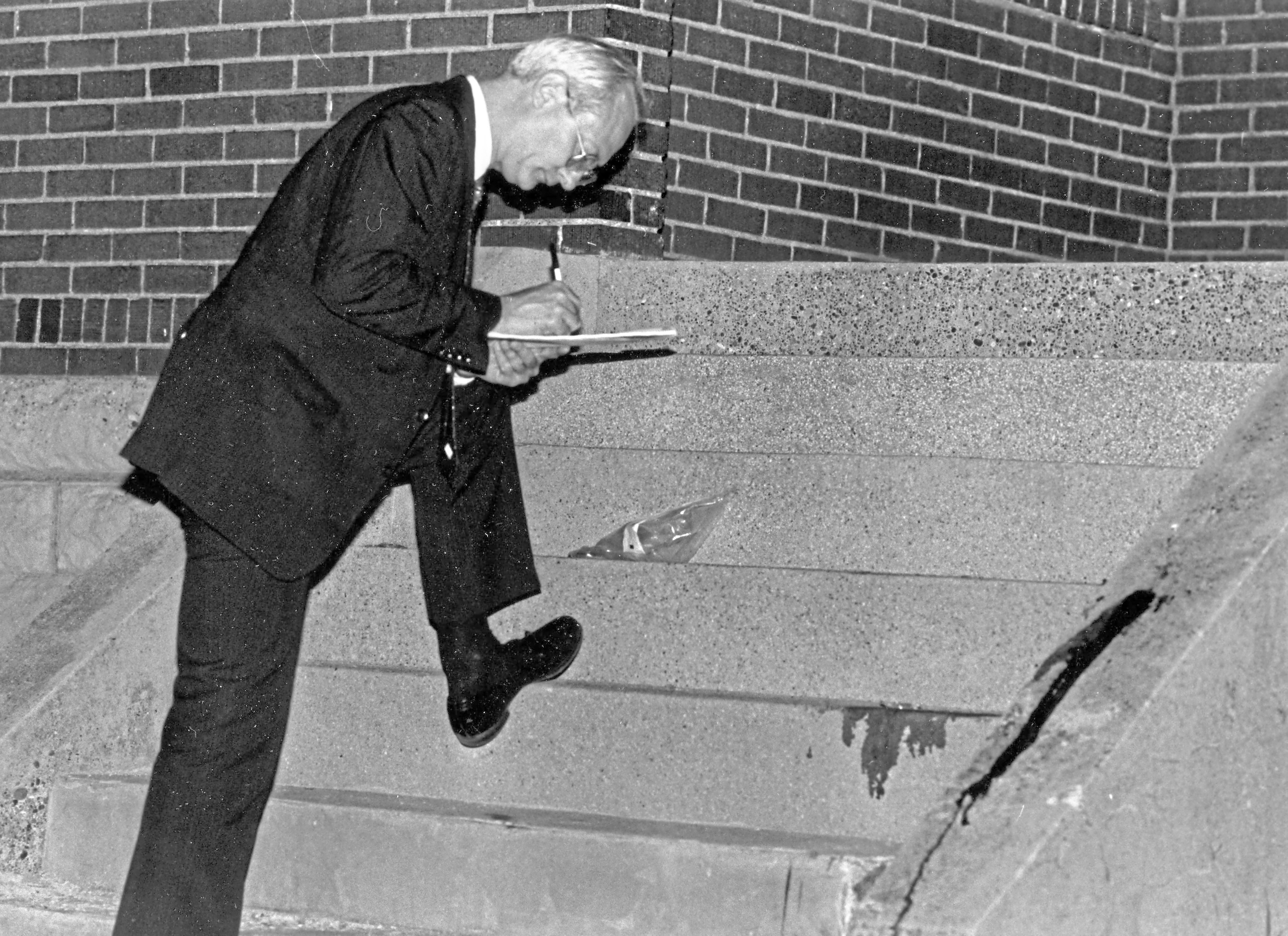
As early as 1981, the Post-Gazette referred to Wilkinsburg as “a community associated with a high crime rate.” That year, the borough reported three homicides, 14 rapes, 164 robberies, 499 burglaries and 695 thefts.
A nationwide wave of crime in the late 1980s and early 1990s hit Western Pennsylvania hard.
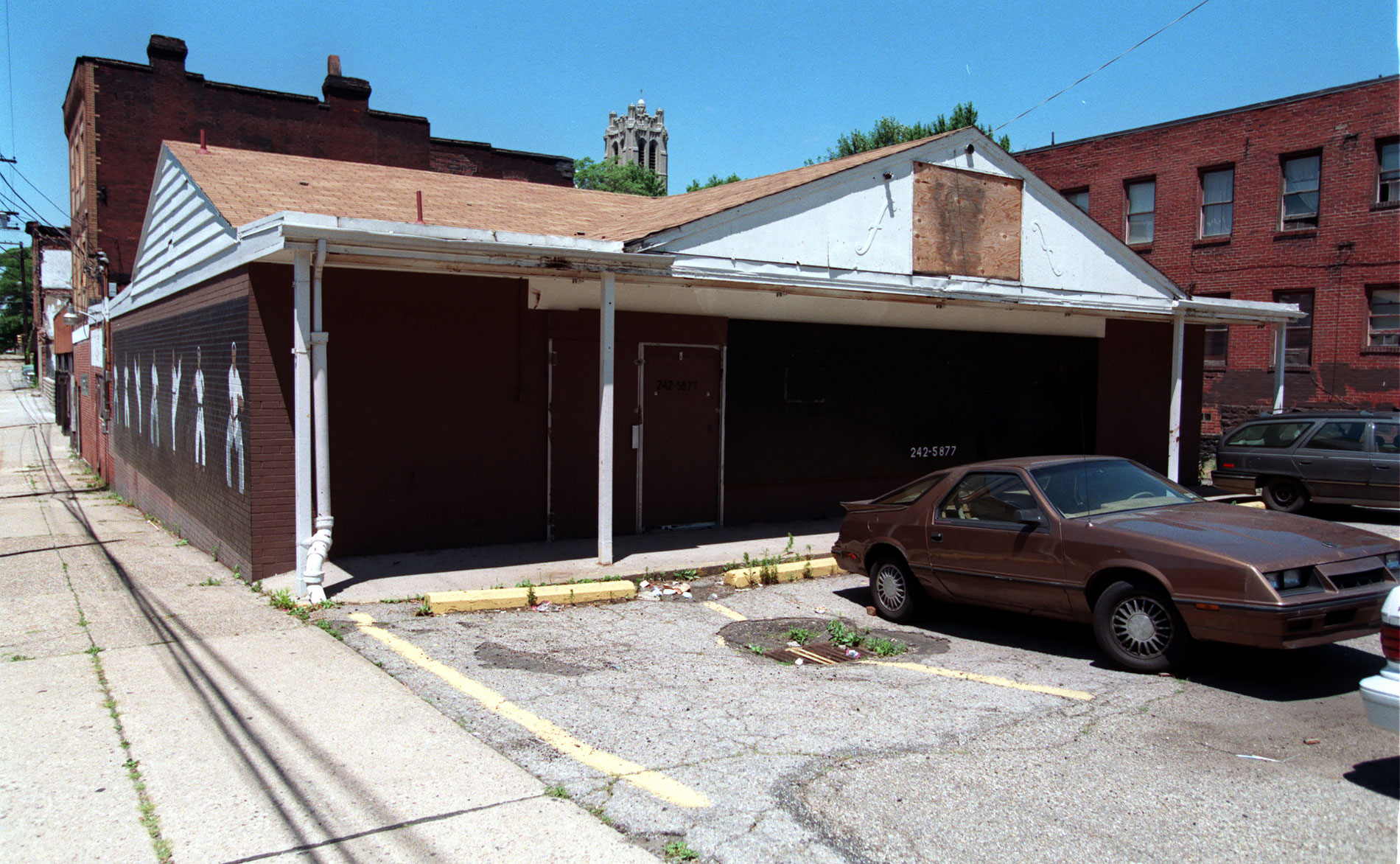
The Crips and the Bloods, both originally Los Angeles street gangs, came to the Pittsburgh area in 1990, according to police accounts in newspaper articles from that time.
In 1993, two Wilkinsburg gangs, the Taylor Way gang and the Larimer Hoodies, united to form the Larimer Avenue/Wilkinsburg (LAW) gang, a November 1996 Post-Gazette article reported. The group’s signature color was black, and it became common to see young men dressed all in black in Wilkinsburg.
The LAW battled the Crips in Homewood and Lincoln-Lemington, and the Bloods in Garfield, the Hill District and the East Hills. Wearing red, the Bloods’ color, outside of Bloods’ territory or blue, the Crips’ color, outside of theirs could result in getting shot.
The LAW controlled the illegal drug trade in Wilkinsburg and committed various crimes including murder, attempted murder, robbery, arson, carjacking and kidnapping, plus attacks and intimidation against local teens. The gang bailed out arrested members, paid for lawyers, bribed witnesses and retaliated against those who testified against them.
In the mid-1990s, school security guards estimated that 60% of the high school’s 600 students were in gangs.
Federal authorities went after the gangs by treating them as organized crime and using the anti-racketeering act. Pre-dawn raids in November 1996 rounded up 43 members on a grand jury indictment.
Between 2005 and 2021, homicides have varied between one and 13 per year and averaged 7.1 per year. In 2021, it had nine homicides, which, compared to its last population count of 14,349 in 2020 would give an approximate homicide rate of 62.7 per 100,000.
By comparison, the city of Pittsburgh had 59 homicides in 2021 and a 2020 population count of 302,971, which gives a rough homicide rate of 19.5 per 100,000.
It is not entirely clear if annexation would be a factor in reducing crime rates in Wilkinsburg, but it would give the community access to the city’s police department, with its 898 full-time uniformed police officers and $74.4 million budget.
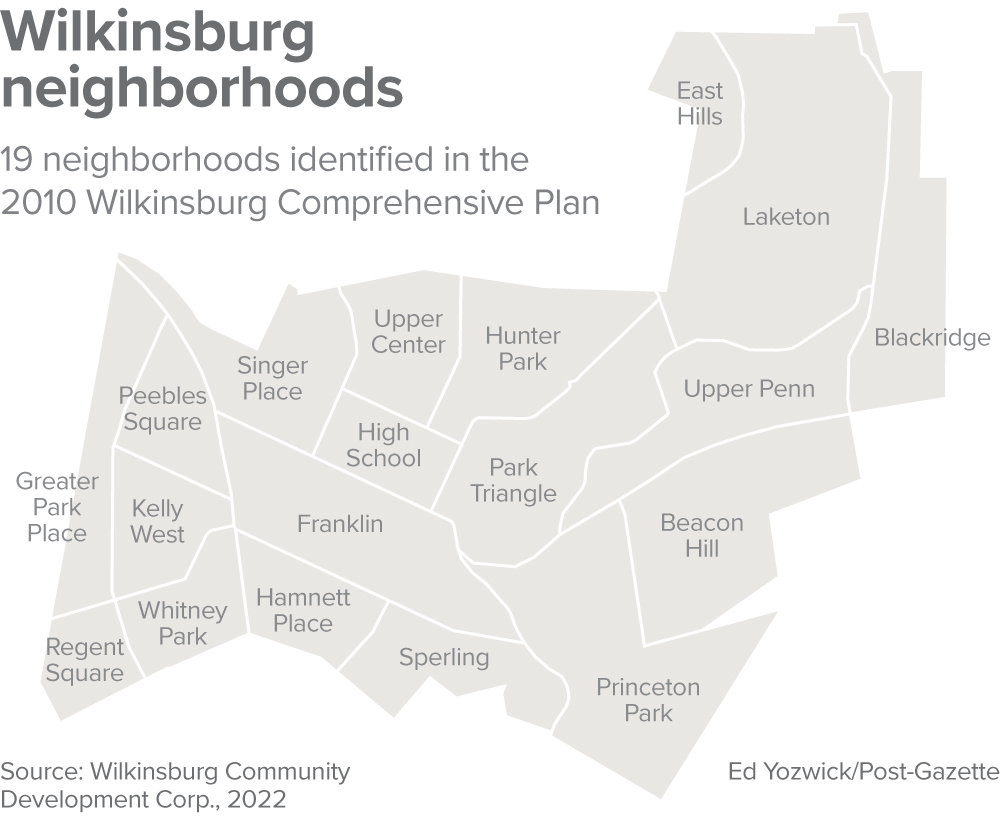
On Sept. 24, 2021, officials unveiled the renovated Wilkinsburg Train Station, built as a stop on the Pennsylvania Railroad in 1916.
More than a century earlier, Wilkinsburg had thrown a three-day celebration to mark the opening of the new station and the raising of the railroad tracks above street level. Before that, passing trains had hit and sometimes killed people at the railroad crossings. A 3-mile-long parade capped the June 1916 festivities, drawing thousands of spectators.
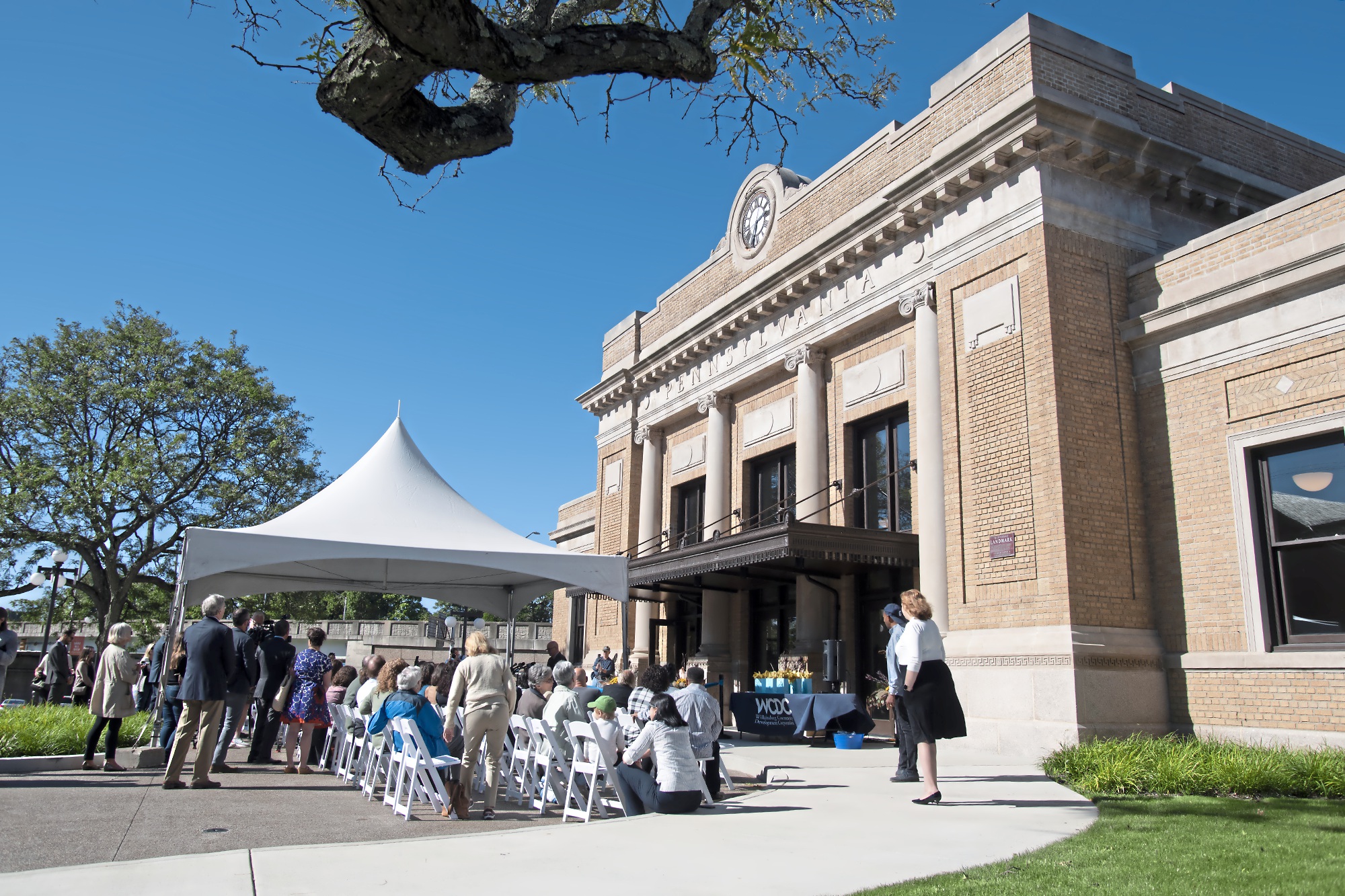
When the decades-old station closed in 1964 because of falling ridership, its end seemed a metaphor for the borough’s flagging fortunes.
The building stood empty for decades, narrowly avoiding demolition, before the Wilkinsburg Community Development Corp. launched a $6.5 million renovation in 2013. The project replaced the old station’s Italian marble, plaster molding, original light fixtures and terrazzo floors. Large holes in the roof were repaired and the graffiti-scrawled crumbling walls restored with their original paint colors.
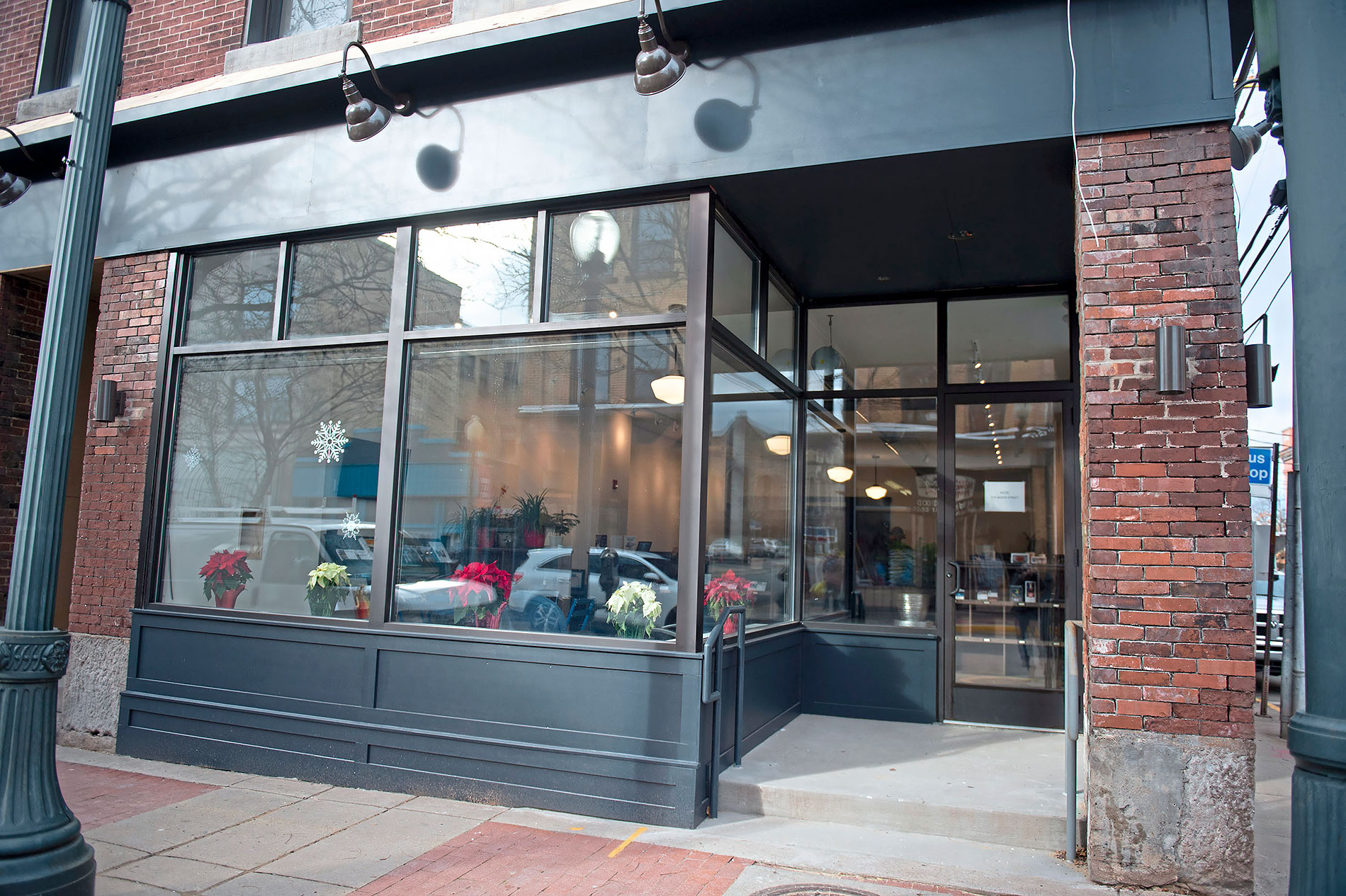
Recently, WCDC Executive Director Tracey Evans said the organization is almost ready to announce two tenants for the lower floor.
As the issue of the city of Pittsburgh possibly annexing Wilkinsburg settles in for what could be a monthslong debate — Pittsburgh City Council voted down the move earlier this year to give all sides more time to analyze the proposals — the assessment inside the community has been intense.
Some point to recent gains, while others express frustration with creeping blight. There are fears of driving out renters juxtaposed against weariness with continued decline.
“I’m ready to try just about anything,” said Douglas Duffus, co-owner of Kenyon Jewelers on Penn Avenue, which has been in business since 1924. “I’ve seen all kinds of plans come and go.”
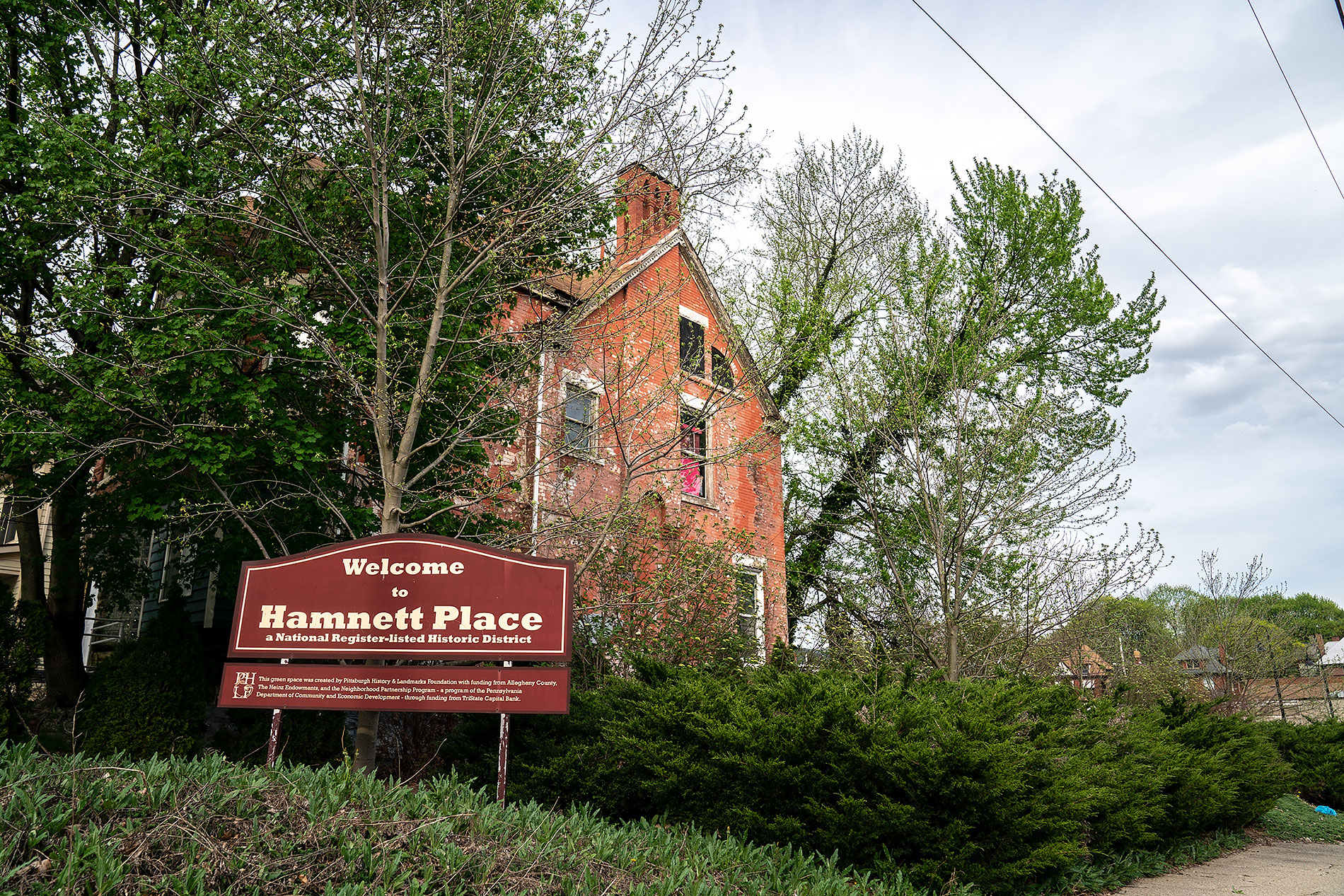
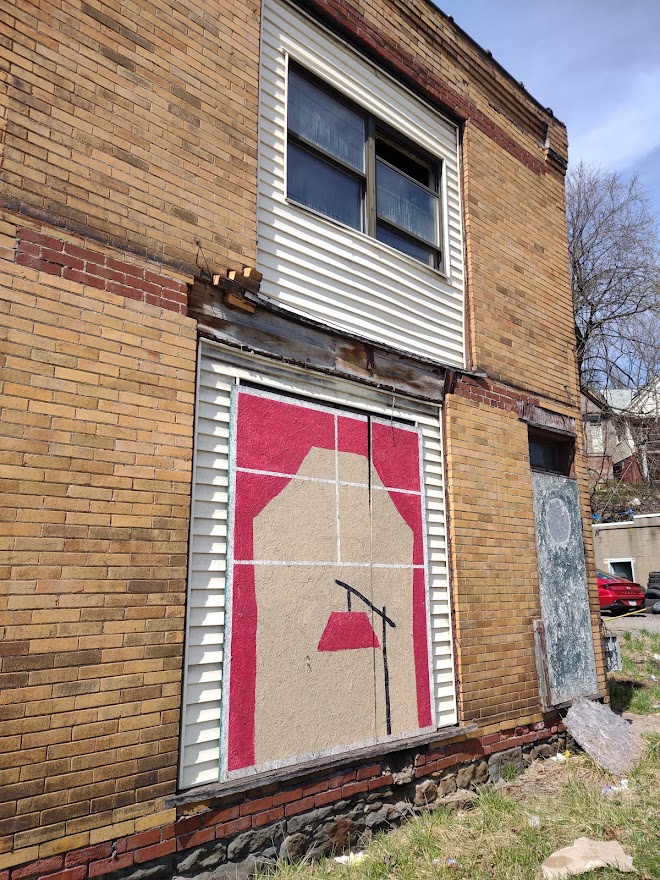
Yet, few deny that — as with the renovated train station — progress has been made.
Another source of borough pride is the Save A Lot discount supermarket that opened in 2006 on Ross Avenue, ending more than two decades of the borough not having a grocery. “We are not a food desert,” said borough council’s Denise Edwards, using a term for a community without easy access to nutritious food.
The development organization finished a $2.5 million renovation of the historic Lohr Building, corner of Wood Street and South Avenue, in 2020. The group now has its office there and is seeking other tenants for the three-story structure.
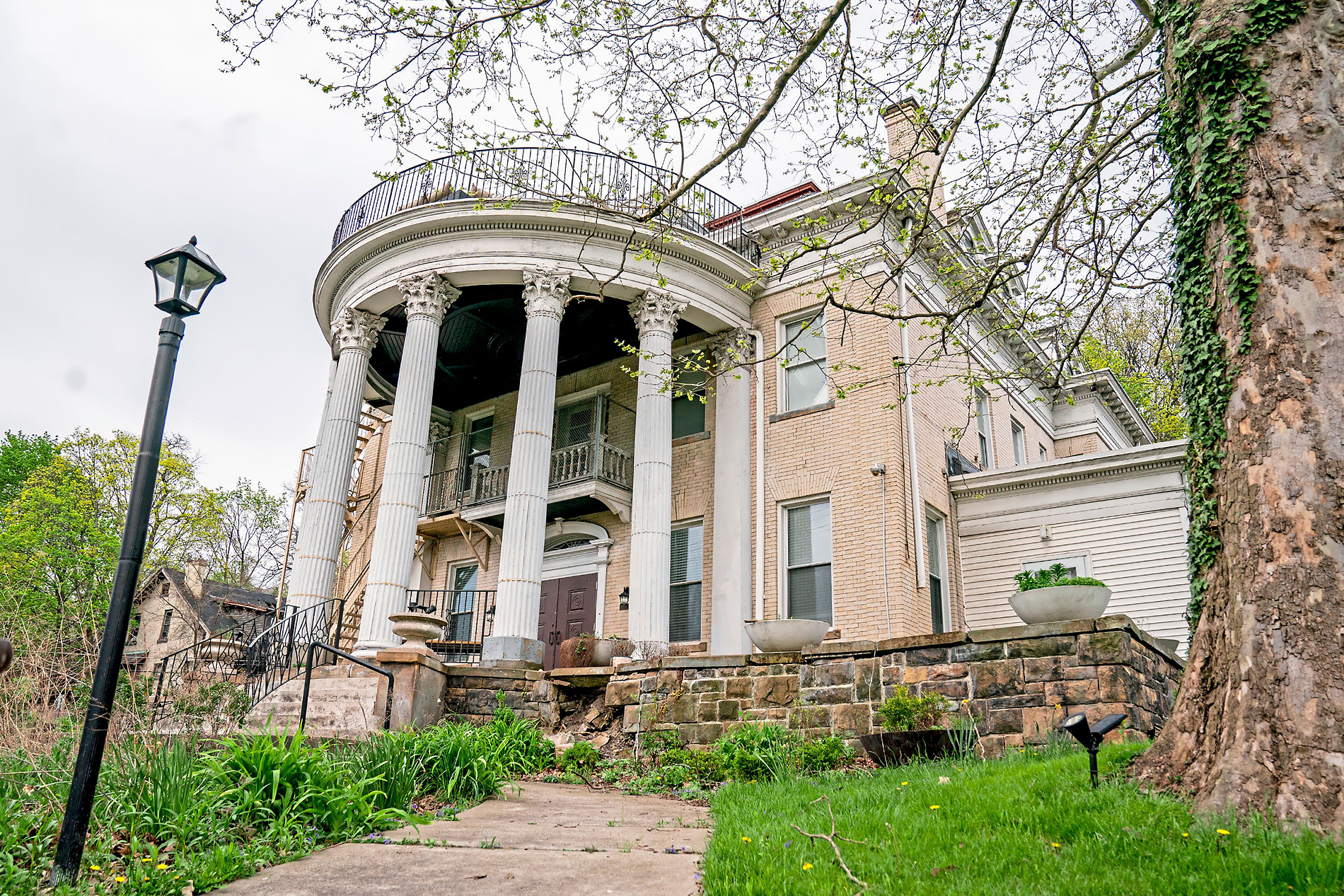
Between 2005 and 2016, the Pittsburgh History and Landmarks Foundation through its nonprofit subsidiary Landmarks Community Capital Corp. and the WCDC upgraded the 114-acre Hamnett Historic District, bordered approximately by Jeannette Street, Rebecca Avenue, Center Street and Lytle Way. The project started with house restoration and went on to apartment buildings, including the Crescent Apartments and Falconhurst Apartment on Kelly Avenue as well as townhouses and other properties. The National Register of Historic Places began listing the Hamnett Historic District in 2010.
Private investment also has contributed to the borough’s improvement. In 2016, artist Nicole Santella paid $175,000 for the three-story, 30-room Yingling mansion on Wood Street. Roswell Gardner Yingling, owner of a Kittanning brick company, had built the grand home in 1905. The family sold it in 1927 to a private Wilkinsburg hospital. After the hospital closed, the building became the Miller Nursing Home, then the Gibbs Personal Care Home.
Ms. Santella and her husband, Brian Sieffert, who owns Lawrenceville design and construction firm Artemis and sits on the WCDC’s board, unveiled the renovated mansion in 2018. It is now the Sleeping Octopus art gallery and event space. Ms. Santella is part of Wilkinsburg United, a group that sought to put its own slate of candidates on borough council.
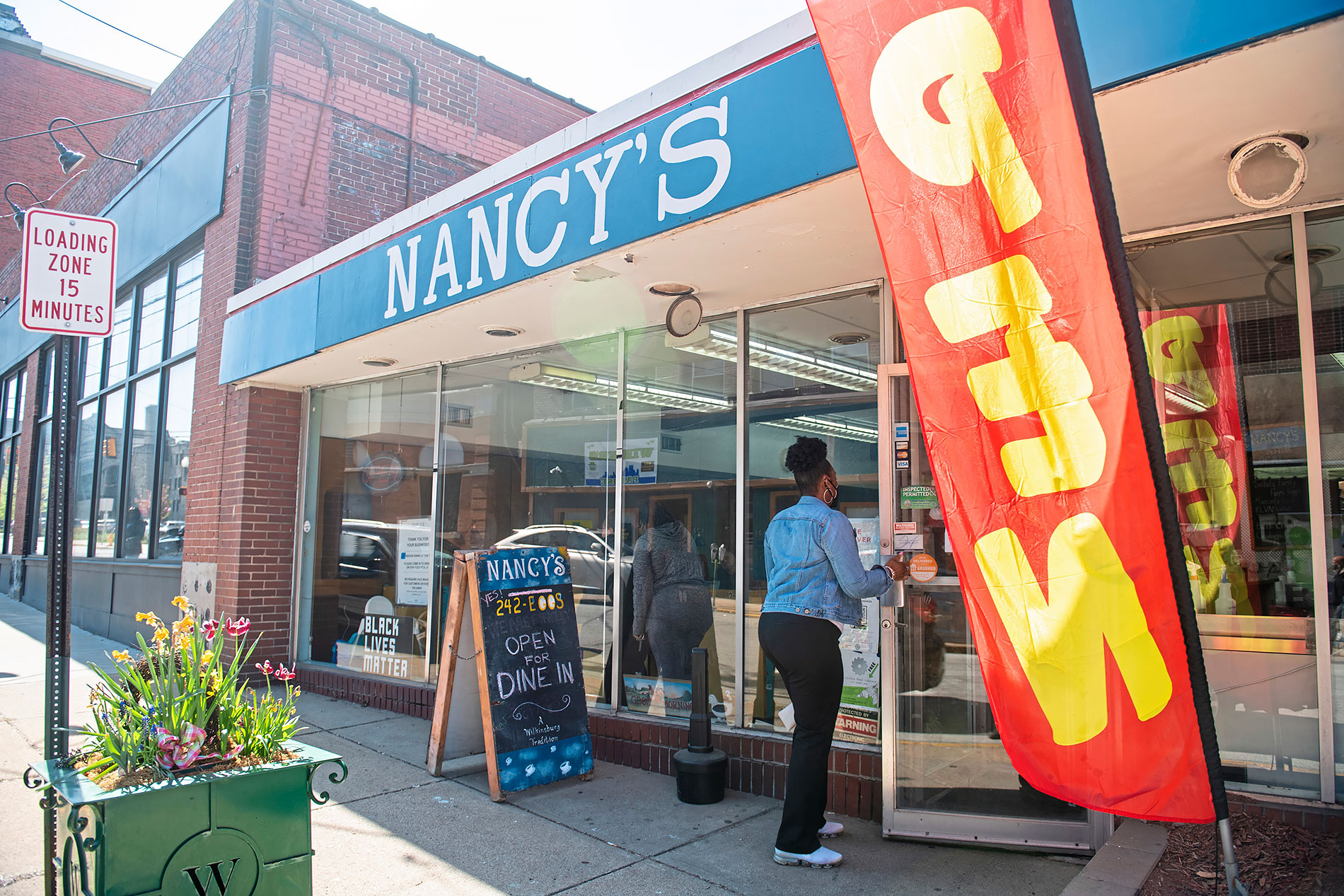

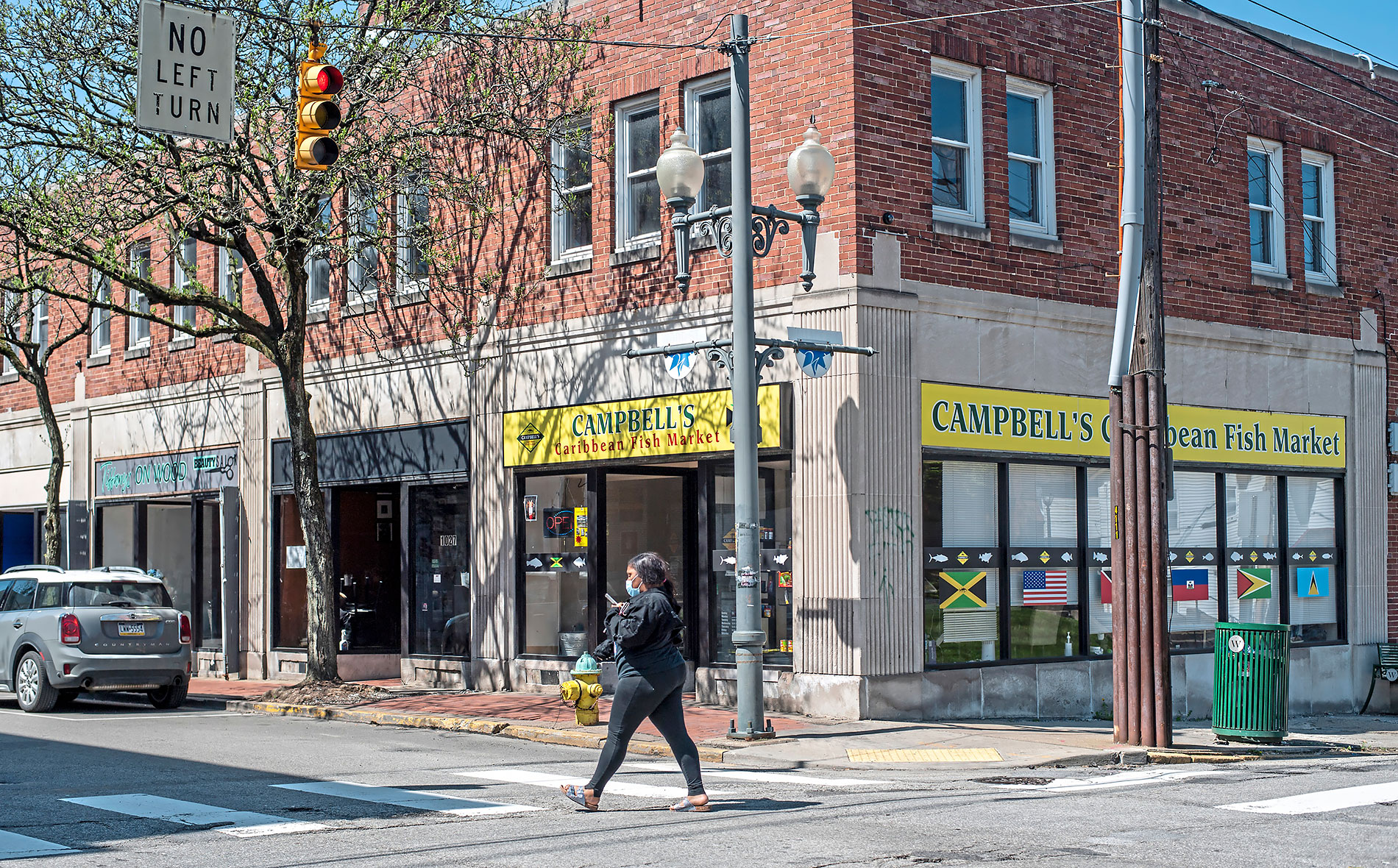
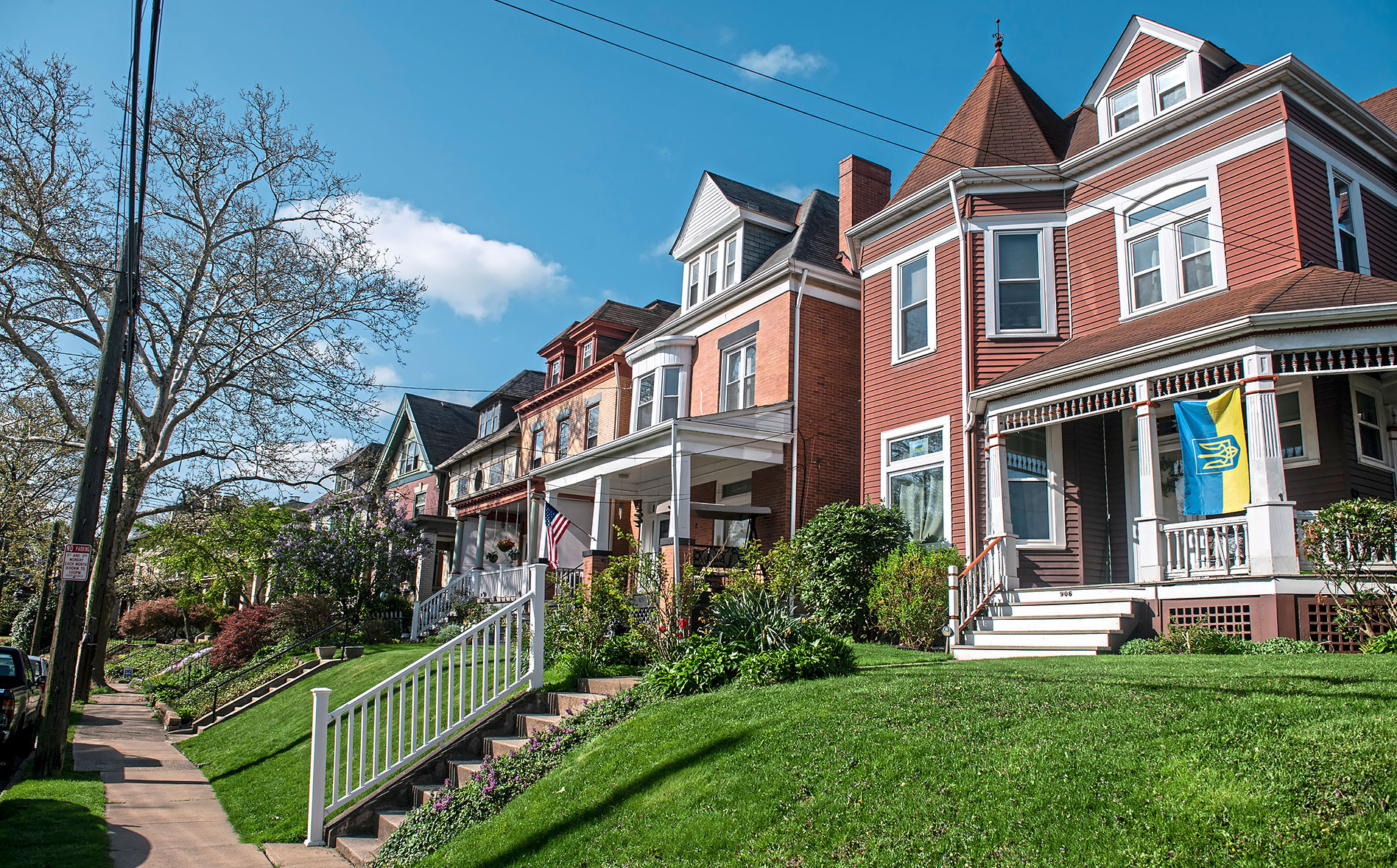
Many other borough improvements involve smaller-scale efforts headed by a variety of nonprofit organizations. The Covenant Fellowship Reformed Presbyterian Church, for instance, has its “Transform the Triangle” program to upgrade the Park Triangle area, which includes painting many of the boarded-up windows in the vicinity with cheery curtains and sometimes the odd lamp or cat.
In April, a state lawmakers announced new state funding projects, with Wilkinsburg to receive one of the largest chunks — nearly $5 million in state grants to construct or renovate several buildings.
The Penn Avenue business district remains patchy, with 38 of the 127 storefronts along Penn Avenue and Wood Street still vacant.
Yet new businesses have opened in the borough, including Campbell’s Caribbean Fish Market on the 1000 block of Wood Street. It joins longtime local favorites such as James Flower Shoppe on Wood Street; Kenyon Jewelers on Penn Avenue; and Nancy’s Revival restaurant on South Avenue.
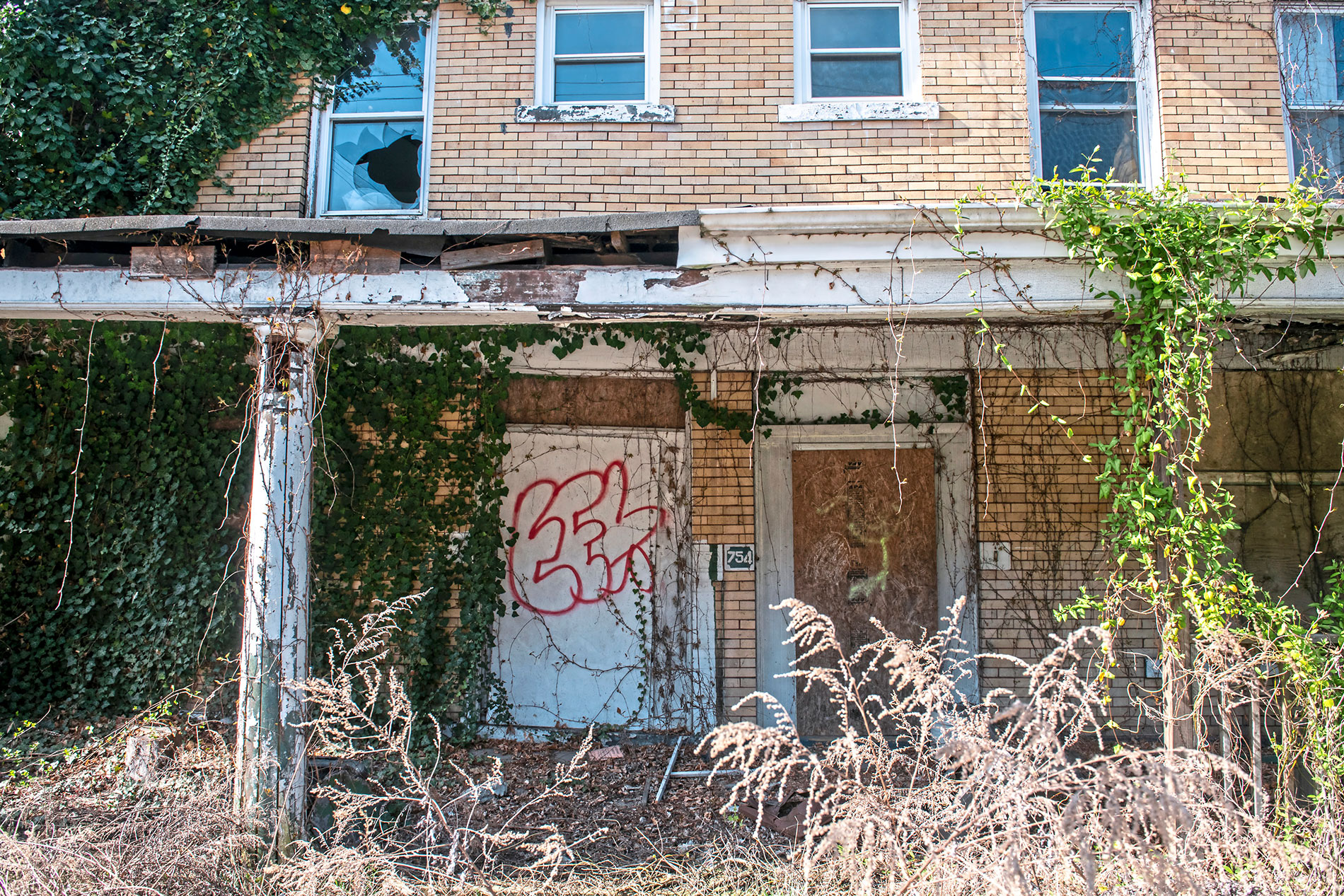
People on opposite sides of the annexation issue view these upgrades much differently. For people in favor of annexation, the improvements are too little to stop the tide of decline. For those opposed, the upgrades represent what is possible and the Wilkinsburg Community Development Corp.’s promotion of annexation is seen as a betrayal.
Shortly before Pittsburgh City Council voted on annexation earlier this year, Wilkinsburg cut ties with the WCDC, saying the organization had “failed in its partnership” with the borough.
“They don’t have any ties” to cut, countered the WCDC’s Ms. Evans.
To her, the bottom line with Wilkinsburg’s problems is the bottom line. “There’s just not enough capacity to sustain an urban community on a stagnant budget,” she said. “Sources of revenue are flat. Expenses keep going up.” Although the borough has successfully sought public funding sources, “We can’t get private investment, and that’s because of the taxes,” she said.
Other residents echoed that sentiment. “Wilkinsburg I think would benefit from being annexed,” said Stan Washington, owner of Freeman Cut & Styles on Wood Street, who cited the borough’s high property taxes.
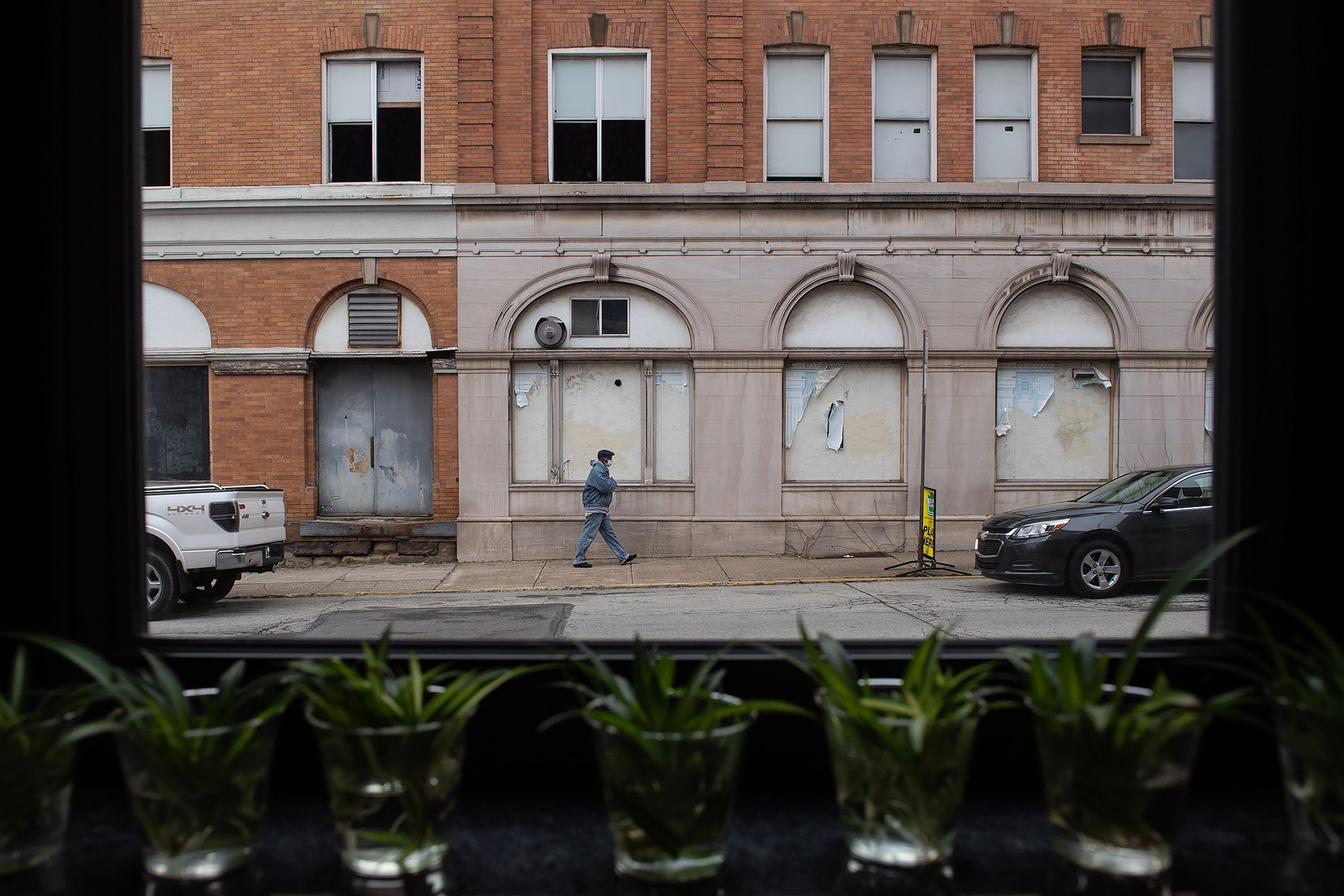
For Wilkinsburg homeowners, becoming part of Pittsburgh would mean lower taxes, even considering Pittsburgh’s higher income tax.
Yet many stakeholders harbor serious reservations.
In a borough in which 65% of residents are renters, they worry that what happened in the East Liberty neighborhood of Pittsburgh will happen to them.

East Liberty suffered from a 1968 urban renewal project that destroyed its commercial street patterns and hastened blight. Three public housing high-rises erected in the early 1960s dominated the neighborhood’s commercial district. Those buildings were razed in 2005 and 2009, while Home Depot, Whole Foods, Trader Joe’s, Target and Google moved in. Housing prices rose and hundreds of residents were forced to move elsewhere.
If annexation brings similar gentrification to Wilkinsburg, renters would have to seek low-rent options to the east — taking them away from the borough’s bus, highway and road access.
“Am I going to have to move?” renter Michelle Snowden said. “Where I am, it’s convenient, on the busway. To move, it’s going to be a very big inconvenience.”
“Where are people supposed to go?” Renée Haynes-Johnson, a local activist, said during a gathering with some council members, another local activist and the Post-Gazette.
Even the Wilkinsburg Community Development Corp.’s tax calculator shows that renters making the median household income of $37,649 per year would pay $752.98 more in income tax if Pittsburgh annexes Wilkinsburg, not counting any hikes in rent.
While they don’t deny the borough has problems with blight and taxes, supporters of Wilkinsburg independence argue that Pittsburgh is unlikely to offer solutions. Pittsburgh has a worse problem with vacant properties than Wilkinsburg, they said. The city has more than 27,000 vacant lots and more than 1,900 condemned properties.
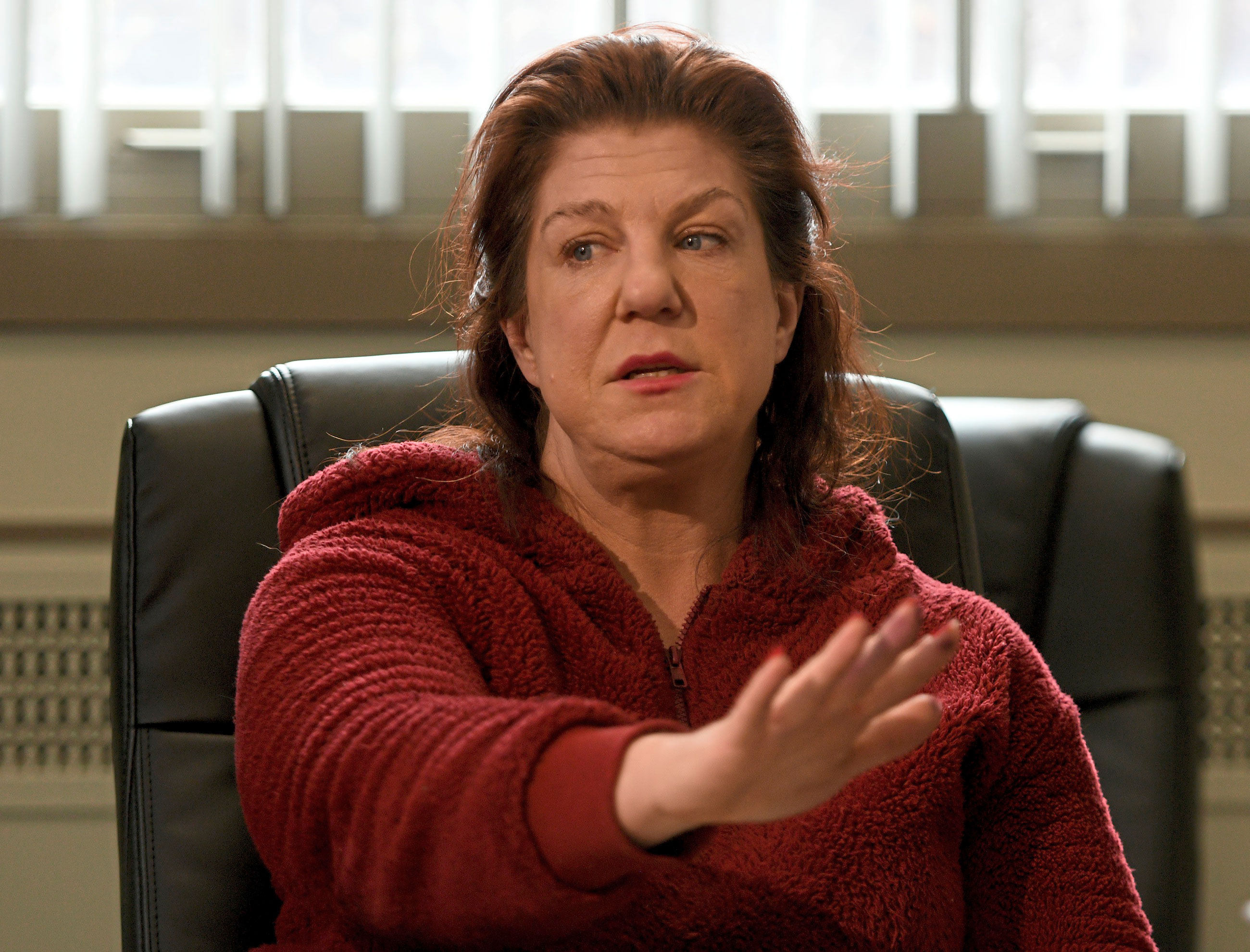
And they are leery of the Wilkinsburg Community Development Corp., which they believe is too cozy with deep-pocketed bankers such as A. William “Bill” Schenck III, TriState Capital Bank vice chairman. TriState, which Mr. Schenck and two partners launched in 2007, serves businesses and wealthy individuals, providing commercial real estate loans and financing as well as other services. It was an early WCDC funder, and Mr. Schenck was the group’s former honorary chairman.
“They [developers] are looking at us because it’s location, location, location,” said Ms. Edwards.

For his part, Mr. Schenck said the development organization’s efforts were not for his benefit but for the borough’s. “If anything, displacement has occurred already, and we’re trying to stop it,” he said, noting that Wilkinsburg’s Black population decreased between 2010 and 2020. “They certainly didn’t leave because of some talk of annexation. They left because of the quality of life in Wilkinsburg.”
Ms. Edwards and other people who oppose annexation believe that becoming a 91st Pittsburgh neighborhood will bump its concerns to the bottom of the city’s list, and they don’t want to lose the borough’s snow removal and other services.
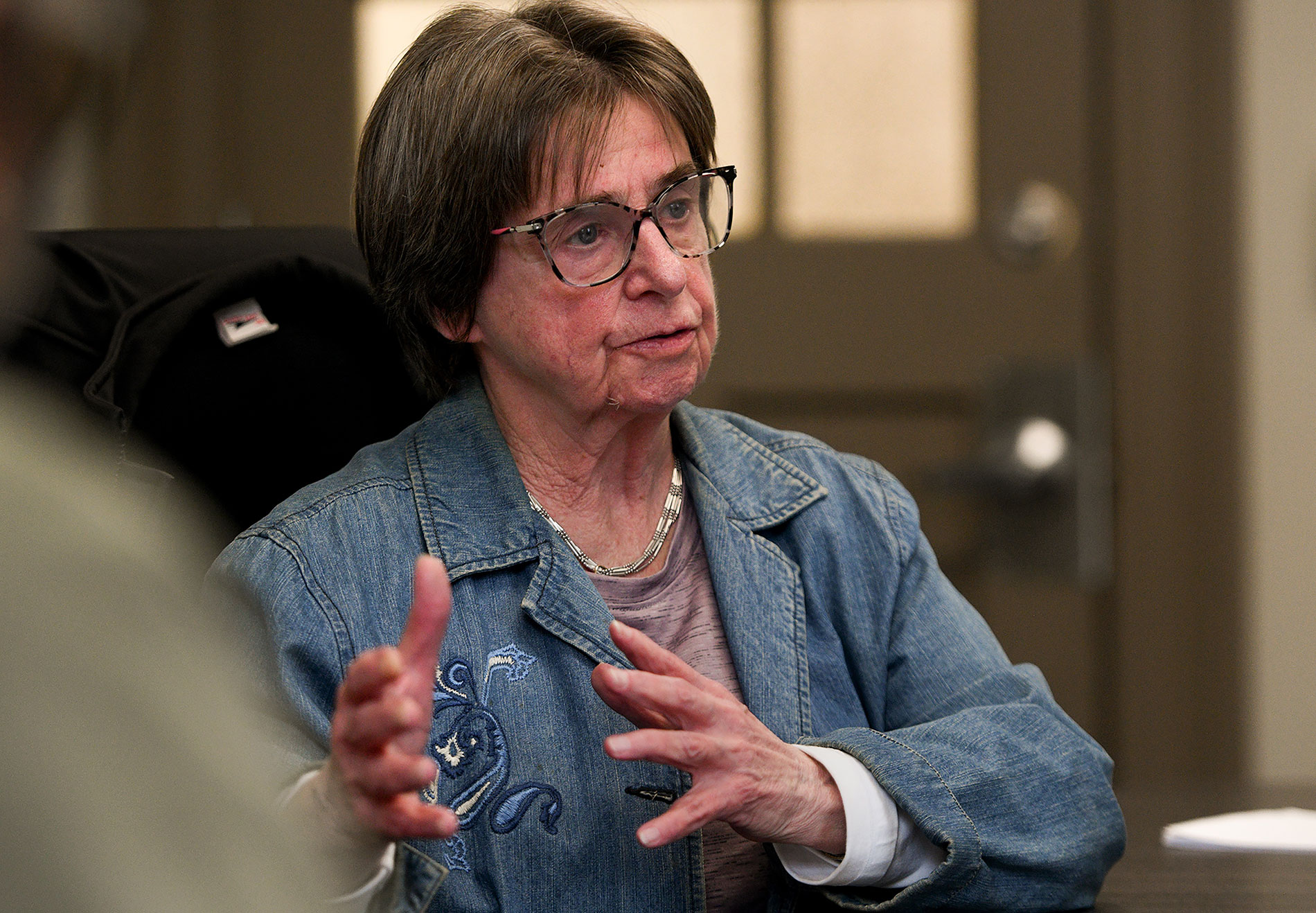
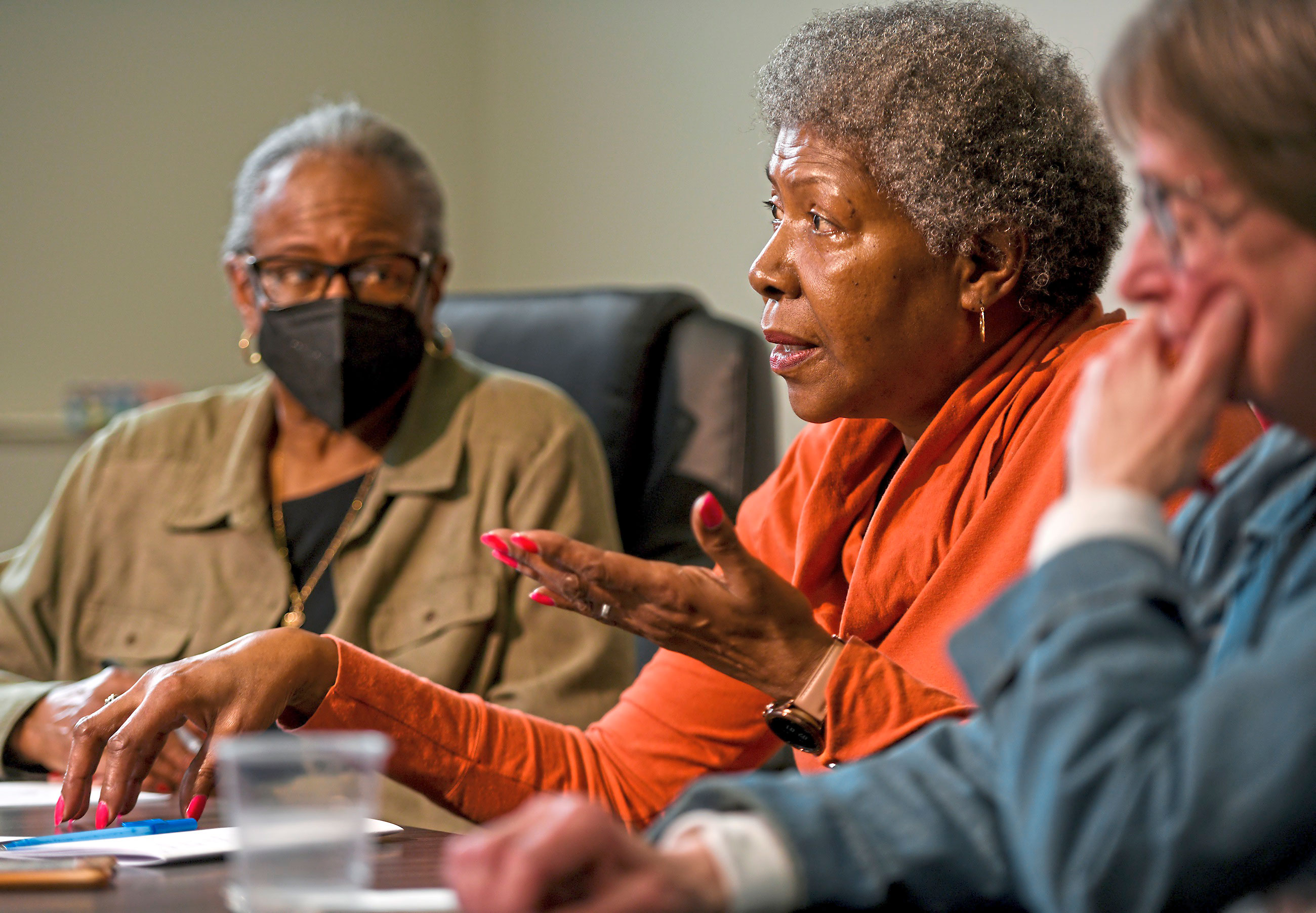
To the Wilkinsburg Community Development Corp., the time for acting is now, before economic trends get worse. “I don’t think anyone disagrees that we all love Wilkinsburg,” Ms. Evans said. But “some people don’t want to see things change. The [borough] properties are not rising in value. You’re not building wealth.”
The fight for Wilkinsburg’s continued independence isn’t over.
“It is wonderful to have autonomy in your own community,” said Linda A. Atkins, council president pro tempore. “That’s the power … to develop our community the way we want to develop.”
Laura Malt Schneiderman, lschneiderman@post-gazette.com
Correction, posted June 2, 2022: The Wilkinsburg school enrollment and the school tax for 2021-22 have been corrected.

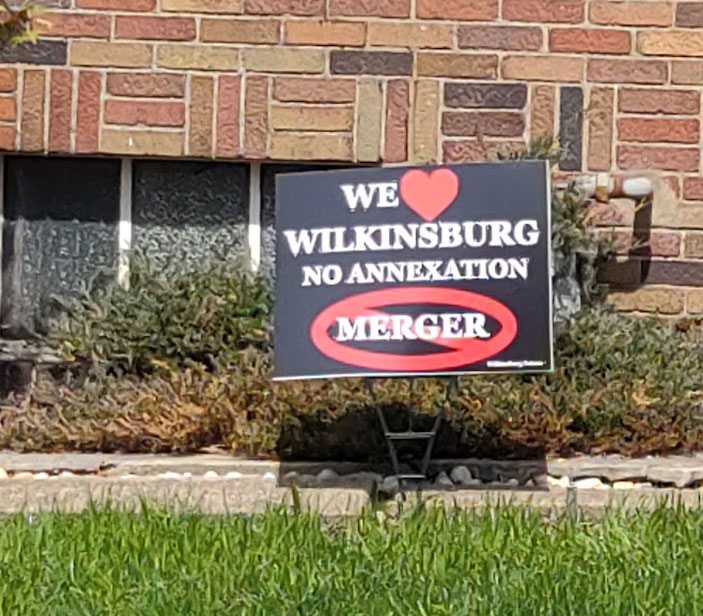
Story
Laura Malt Schneiderman
Design
Ed Yozwick
Development
Laura Malt Schneiderman
Graphics
Ed Yozwick
James Hilston
Photos
Stephanie Strasburg, Steve Mellon, Alexandra Wimley
Advertisement
Advertisement
